






























Community is about being a part of something bigger than yourself. Where you know you care about people and they care about you. It’s where you feel comfortable and at home.

At Beacon Hill, we’ve built a retirement community for our residents to share with each other and the neighbors around us — and to be an important part of life in Grand Rapids. From the restaurants to the auditorium, everything at Beacon Hill is built to be shared.








With the morning sun streaming through the studio windows, this is the perfect time to meet up with friends for a Cardio Drumming class. Feel the energy and the excitement as part of a whole group moving together — and feel invigorated for the rest of the day.




Only steps away from your class is the Bistro, where you can grab a handcrafted coffee and a homemade pastry together and plan the rest of the day. And don’t forget to say hi to friends as they linger over breakfast.




From the fall colors to the spring blooms, the view from the wall-to-wall windows in the art studio is inspiring all year round. Take a class from one of our experienced teachers, or work on your own, personal project. Whether you’re crafting, creating, or curating, The Studio is the perfect setting for artistic expression.


After a fun day with friends, unwind in the cozy, upscale atmosphere of our steak and seafood restaurant, the Club Room. The wine and beverage pairings are a perfect complement to the chef-curated steakhouse experience, sourced and handselected from renowned experts.


Kent County has inde nitely delayed plans for a $380 million sustainable business park and bioenergy plant as its primary business partner and anchor tenant struggles to remain solvent.
e developer behind a $220 million redevelopment near Muskegon Lake is doubling down in the area with a plan to convert a sprawling former paper mill site into hundreds of housing units, retail space and a marina.
Parkland Properties is under contract to purchase the 122-acre former Sappi Paper Mill site on Muskegon Lake. e project, known as Windward Pointe, marks yet another major redevelopment of former industrial

property along the lake, which includes Parkland Properties’ plan to redevelop the former Shaw Walker Furniture Co. property near the Muskegon Lake shoreline.
“We are fortunate to be able to focus on projects that we believe will have profound, positive impacts on communities. We felt the former Sappi Paper Mill (Windward Pointe) and Shaw Walker Furniture Company sites provided opportunities to really make a lasting di erence on Muskegon and the West Michi-
gan community,” Parkland Properties President Jon Rooks said in an emailed statement to Crain’s Grand Rapids.

“At their peaks, both the Sappi Paper Mill (Windward Pointe) and Shaw Walker Furniture Company each employed thousands of people and were assets for Muskegon and the greater lakeshore area,” Rooks added. “We believe the repurposing of these important sites into much needed housing developments will
Burlington, Ontario-based Anaergia Inc. was selected in 2021 to enter into a project development agreement with the Kent County Department of Public Works (DPW) for the Kent County Bioenergy Facility, the intended anchor tenant for the county’s broader Sustainable Business Park.
However, the county Board of Commissioners recently delayed a vote to advance the project while DPW reviews its partnership with Anaergia in light of a dire nancial situation for the waste solutions company.
“Over the coming months, the Kent County Department of Public Works will continue its due diligence on the Kent County Bioenergy Facility project and how changes in Anaergia’s nancial
position may impact this project,” Dar Baas, director at Kent County DPW, said in a statement provided to Crain’s Grand Rapids. “After consulting with the Kent County Board of Commissioners, we have delayed any vote while our review and due diligence takes place.”
Anaergia has not responded to a request for comment.
In August, Anaergia reported its most recent nancial results for the second quarter of 2023, which CEO Brett Hodson said in an earnings call with analysts was “a di cult and challenging time for Anaergia.”
While the company’s revenues increased slightly at 1.5% from the same period last year, the
Kent County business leaders are highlighting the crucial role that immigrants play in the local economy by helping to meet employers’ labor needs while preserving or creating jobs that would have otherwise been eliminated or moved elsewhere.

According to a report released last month, 38.2% of Kent County’s population growth from 2014-2019 was attributable to im-
migrants. As of 2019, immigrants made up 8.9% of the county’s total population as the immigrant population grew faster than the overall population.
e report, published by the American Immigration Council in partnership with the Grand Rapids Area Chamber of Commerce and the chamber’s West Michigan CEO Council, shows that immigrant population growth also is leading to more spending power and contribu-

tions to the federal safety net, including $192.3 million to Social Security and $47.8 million to Medicare in 2021.
In 2019, immigrants in Kent County earned $1.7 billion, and were left with $1.3 billion in spending power after $266.3 million went to federal taxes and $142 million went to local taxes.
“It’s not surprising to me to see all the contributions that are
For nearly two decades, our Student Leaders® program has helped prepare community-minded high school students to become successful in the workforce by connecting them to skills development, service and leadership training. Through paid internships with local nonprofits like Family Promise of West Michigan, they gain practical work and life experiences. It’s just one more way we’re working together with our communities to build a better future for all.
 Renee Tabben President, Bank of America Grand Rapids
Renee Tabben President, Bank of America Grand Rapids



What would you like the power to do?®

Construction is set to start this month on plans to convert downtown Grand Rapids riverfront property into a pedestrian-focused park and plaza, which local officials say could be the “first domino” for broader Grand River activation.
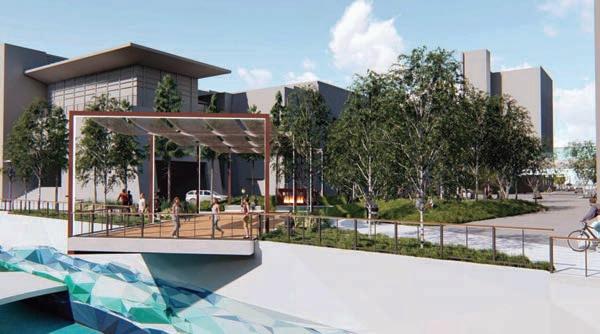

The Grand Rapids Downtown Development Authority on Sept. 13 unanimously approved a funding agreement for the years-inthe-making Lyon Square develop-
ment. Project backing includes $2.6 million in donations, while the DDA would pay 80% of the debt issued to complete the project under a 20-year capital improvement bond not to exceed $12 million. The Grand Rapids City Commission is expected to approve the bond at an upcoming meeting.
The project is situated at the west end of Lyon Street NW, between the Amway Grand Plaza Hotel and DeVos Place. Rockford Construction Co. is leading the
build out.
“This is what we think of as one of the first new pieces of the development of the whole entire greenway we’ve been talking about for many years,” said Mark Miller, director of planning and design for Downtown Grand Rapids Inc.
“When we think about the greenway, it’s not just trails, but places in the trails and linear parks. We think of this as more of a plaza that creates yet another place we can
CertifID LLC has raised $20 million in venture capital funding that will help the company grow, innovate products and move its cybersecurity platform into additional industries.
The Grand Rapids region has added more than 3,000 technology-sector jobs since 2021, a sign of “really good momentum” as local leaders work toward goals laid out a year ago under a 10-year tech strategy.
Economic development officials on Sept. 20 released a progress report one year after debuting the 10-year tech strategy aimed at positioning Grand Rapids as a Midwest tech hub. The Right Place Inc. shared the first of several planned annual progress reports highlighting job growth, new partnerships and other updates for the greater Grand Rapids area’s technology sector.
The strategy announced in September 2022 set a goal for 20,000
new tech jobs in Grand Rapids over the next decade, bringing tech to 10% of all regional employment.
Officials say they hope to keep building on the progress outlined
Place. “Now the key, of course, with momentum is that we’ve got to keep it going. That’s where our attention is.”
According to the progress report, 3,352 tech jobs have been added in the region since 2021, against the goal of 20,000 new jobs. Since 2022 through August, the number of people working in new tech jobs has increased from 37,816 to 38,721.
The equity capital round with Minneapolis, Minn.-based Arthur Ventures more than doubles the amount that the Grand Rapids- and Austin, Texas-based CertifID has raised since its formation in 2017 as a cybersecurity platform to protect electronic fund transfers in real estate transactions.
The funding round will help CertifID “continue to evolve in this space of identity verification and making the transfer of funds safe,” Executive Chairman Thomas Cronkright II said.
“As we do that, other verticals will come into view where the application of what we have perfected in real estate is portable into those other verticals,” Cronkright said. “This is a big problem and it’s a complicated problem. We have to stay curious and committed to making the world a place where you can transact or you can interact with somebody without the threat of some type of financial loss.”
CertifID has developed software to protect wire transfers in real estate transactions. The software platform verifies the identity of parties in a transaction to prevent business email compromise in which a cybercriminal impersonates a party in a transaction to intercept electronic payments through false instructions for a wire transfer.
The fast-growing company, which doubled revenue and customers in the past year, helps to safeguard transactions for title agents, law firms, lenders, real estate agents, buyers and sellers and protects some 750,000 transfers annually.
in this year’s report.
“(We’ve had), I think, really good momentum,” said Randy Thelen, president and CEO of The Right
“When we started the tech strategy about two years ago, we surveyed area businesses, and three out of four said they were looking to add tech employment,” Thelen said. “That’s starting
The Series B venture capital investment that CertifID recently closed follows a $12.5 million Series A capital round in May 2022 that also included Arthur Ventures. The DeVos family’s Wakestream Ventures and Grand Angels, both based in Grand Rapids, and Detroit-based Invest Michigan previously invested in the company.

“CertifID is addressing a growing problem in an industry looking for modern solutions,” Patrick Meenan, general partner at Arthur Ventures, said in a statement on the investment in CertifID. “Despite the challenges posed by a decelerating housing market, CertifID stands out as a technology leader with a mission of utmost importance to the U.S. economy.”
Since launching, CertifID has helped to protect billions of dollars from attempted fraud attacks and recovered $60 million that fraudsters stole from victims,
the 10-year plan is to position region as a Midwest hub
“When we started the tech strategy about two years ago, we surveyed area businesses, and three out of four said they were looking to add tech employment.”
Randy Thelen, president and CEO of The Right PlaceThomas Cronkright II, CertifID | MArK SANcHeZ
Grand Rapids-based insurance brokerage and fintech Acrisure LLC has secured the naming rights to a riverfront amphitheater with a $30 million donation in support of the $184 million project.
The years-in-the-making riverfront venue, to be known as Acrisure Amphitheater, will be a 12,000-seat outdoor concert and event venue at 201 Market Ave. SW downtown.
Co-chairs of the fundraising and development leader on the project, Grand Action 2.0, announced the name of the future venue at a press conference Sept. 22 at the Grand Rapids Downtown Market, alongside community leaders.
Acrisure’s $30 million donation to the $184 million project, along with other commitments, puts the project’s fundraising campaign past the halfway mark of its $70 million goal for private donations. Acrisure will secure the naming rights in perpetuity.
“As you look at the things the community has in terms of momentum and the projects and collaborative spirit in terms of economic development, this is an unusual place,” Acrisure Chairman and CEO Greg Williams told Crain’s Grand Rapids Business. “The economic development and
tenacity and collaborative spirit that exists in this community is unique and different and special. From that standpoint, we wanted to take a lead and make a statement. Given our size and scale of the company, we’ve got a responsibility to give back.”
Grand Action 2.0 also aims to secure $114 million in public dollars to complete the project, which the group plans to do with the help of the state’s Transformational Brownfield Program.
Michigan’s Transformational Brownfield Plan program was amended in July to expand the tool in several ways, including making the funding more available to entertainment, housing and hospitality projects.
Grand Action 2.0 expects to submit its application for transformational brownfield credits within
the next 90 days, said Grand Action 2.0 Executive Director Kara Wood.
“Today is a great day to celebrate our lead donor for this project and build the momentum to continue the fundraising effort that’s needed to complete the project,” Wood said.
Progressive AE is the amphitheater architect and plans to have schematic designs for the venue finalized soon. Pioneer Construction and Barton Malow are leading construction of Acrisure Amphitheater, which is expected to break ground in 2024, and is slated for completion in 2026.
The Grand Rapids-Kent County Convention/Arena Authority (CAA) would eventually take over ownership and operations for the new venue, and hopes to hold the first concert at Acrisure Amphi-
theater in May 2026. The CAA plans to host more than 54 ticketed performances in addition to community celebrations and events to attract 300,000 visitors to the venue each season.
The amphitheater is part of a larger riverfront vision that spans 31 acres along the Grand River. The development is expected to attract new restaurants, bars, retail and 1,700 new housing units for people of all income levels.
“My hope is that all of that land is redeveloped, and I think the amphitheater acts as a catalyst for additional provide redevelopment along Market Ave.,” said Grand Rapids Mayor Rosalynn Bliss. “To me, today is really exciting and solidifies the fact that this amphitheater is going to happen. This project has been talked about for years and years and what I’ve heard from so many people are questions on if it’s ever going to happen. Today we’re saying absolutely, without a shadow of a doubt, the amphitheater is going to happen.”
The CAA has a $24.3 million option agreement with the city to purchase the amphitheater site, and both parties have agreed to allow construction work to start on the site before the property deed is officially transferred. The city is in the process of relocating several existing city functions on the site to an interim location by May 2024. City operations are expected to be fully off the property in November 2024.
Acrisure’s investment in the am-
phitheater also serves the company from a talent retention and recruiting perspective, Williams said.
“Employees take real pride in these kinds of projects,” Williams said. “Given that it’s our home, employees spreading the good will and good word helps keep them and attract others going forward, those two things go hand in hand.”
Acrisure is one of the world’s largest and fastest-growing insurance brokerages, and solidified its presence in Grand Rapids when the company opened its new $33 million headquarters at 100 Ottawa Ave. SW in Studio Park in August 2021. The company employs 1,100 people in West Michigan, with the majority working from the Studio Park office.
The amphitheater is Acrisure’s latest naming rights deal for prominent event and sports venues. Acrisure’s name is on several stadiums and arenas across the country, following the company’s first naming rights deal it signed in January 2022, a 10-year deal to secure the name “Acrisure Arena” for a new sports and entertainment venue in Palm Springs, Calif. Another deal includes the naming rights for the former Heinz Field in Pittsburgh, home of the NFL’s Pittsburgh Steelers, which was secured last year under a 15-year contract that local media reported at the time was worth $150 million. The national brand awareness is part of the company’s aggressive M&A strategy.

The city of Walker’s decision to suspend residential permits, including for projects already in the pipeline, sits in a murky area of case law that experts say could potentially cause the city litigation headaches.
The Walker City Commission on Sept. 11 voted unanimously to temporarily amend the city’s code of ordinances, placing a six-month emergency moratorium, effective immediately, on residential building permits, demolition permits, land divisions, land combinations, lot line adjustments or other similar approvals for projects with a density of three-and-a-half units per acre or greater.
Brad Neumann, a certified planner, land use expert and educator within the Michigan State University Extension’s Public Policy department, contributed to an article in August advocating caution to municipalities as they consider such moratoria.
He wrote that since Michigan does not have a statute on the
books addressing moratoria, cities face legal risks in the process and should involve their municipal attorneys before proceeding.
Walker did consult with its city attorney, who also was present at last month’s city commission meeting.
Neumann was not immediately available for an interview, but his colleague and fellow land use planning expert at MSU Extension, Ryan Coffey Hoag, said it’s a “legal gray area” that involves some “calculated risks” on the part of cities.
The MSU article, co-written with Kurt H. Schindler, said the key element in mitigating risks is timing.
“An old joke suggests that a moratorium should always be shorter than the amount of time it takes for someone to file suit and have the case come up on the court’s docket,” they wrote. “The goal being that the moratorium should always be shorter than the adjudication of the lawsuit.”
Sara Lachman, a partner with Grand Rapids-based law firm Lachman King PLC, which has a zoning, land use and development practice, said both the Michigan Court of Appeals and the U.S. Supreme Court have upheld moratoria enacted by various cities. Examples include the decisions in Central Adversiting Company v. St.
Joseph Township and Tahoe Sierra Preservation Council Inc. v. Tahoe Regional Planning Agency.
The first case was regarding a moratorium placed on new billboards until the Southwest Michigan township could develop a sign ordinance. The second was around pausing development in the Lake Tahoe Basin while the regional planning agency formulated a comprehensive land-use plan for the area.
Both decisions were upheld, and key to both those cases was the length of time a moratorium lasts, Lachman said.
“It should not be longer than needed to accomplish the objective, but how long that might be is up for some interpretation. But there have been (moratoria) of six months or to a year that have been upheld,” Lachman said. “Maybe put better: The case law suggests that a moratorium of less than one year may well be considered reasonable.”
Walker Mayor Gary Carey said conversations with the city attorney made him feel confident the timeline Walker chose is reasonable.
“We believe that the timeline is
short enough, planned-out enough, and quite frankly, aggressive enough that by the time something would even get to a courtroom to be litigated, that the moratorium is lifted, that we’re moving forward,” he said.
Lachman said it’s also been recommended in past case law that the administrative process for any moratoria should include an appeals process, which the Walker moratorium does.
According to Walker’s ordinance: “Any applicant seeking a permit or approval to which this moratorium applies may appeal the application of the moratorium to the City Commission. The appeal shall be in writing and identify in detail why the moratorium should not apply due to unique circumstances affecting the subject property. The City Commission shall schedule and hold a hearing to consider the appeal and its decision shall be issued in writing within a reasonable time thereafter.”
The Walker ordinance also lists a number of exemptions, including any projects that have “obtained approval of all zoning compliance permits, zoning approvals, rezonings, variances or similar approvals, as required by the Zoning Ordinance to complete the construction or development.”

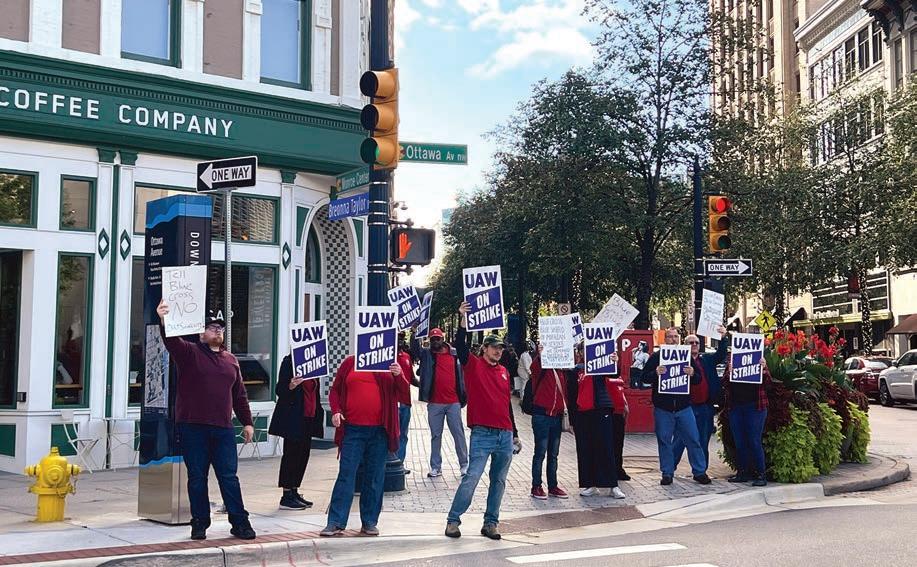 By Kayleigh Van Wyk
By Kayleigh Van Wyk
West Michigan’s relatively high concentration of lower-tier automotive suppliers places the region’s manufacturing sector at heightened risk from a prolonged UAW strike against the Big Three automakers.
Economists and industry analysts say these manufacturers farther down the production chain could resort to layoffs, or even closures, should the UAW’s strike that launched mid-September at three targeted General Motors, Ford and Stellantis plants persist.
As of press time, there was no settlement and threats of a longer work stoppage were looming.
Long-term, the strike could pose problems for Tier 2 and Tier 3 suppliers in the region whose balance sheets haven’t yet corrected from the COVID-19 pandemic, said Paul Isely, professor of economics and associate dean at Grand Valley State University’s Seidman College of Business. This could result in an increase in M&A activity or some suppliers going out of business, he said.
“On this side of the state, we have people further down the chain, and the further you are down the chain, the more likely it is that you’ll shut down sooner,” Isely said.
Mike Wall, executive director of automotive analysis at S&P Global Mobility, echoed the potential threat to Tier 2 and 3 suppliers in this region, saying that layoffs for some could begin soon.
“Most of what we have around here are Tier 2 and Tier 3 suppliers, and those are the ones that are particularly exposed here because they’re not publicly traded, they don’t have access to capital markets, they’re smaller … they’ve been put through the wringer over these last two to three years,” Wall
said. “And now at a point in time when they’re finally starting maybe to rebuild their balance sheets, this happens.”
Wall added that while there is never a “good time” for a strike, “this is the absolute wrong time” given recent signs of improvement for the supply chain.
“The supply chain itself has been through proverbial hell over these last three and a half years … and now we’re finally starting to get production a little bit closer to normal. We’re not fully there yet, but we start to see production improving. This kind of pulls the rug out from under us,” Wall said.
Isely estimates that the UAW strike against the Big Three could cost West Michigan’s economy
ferred to a multiplier effect that could affect the broader economy beyond just the automotive industry.
“If a supplier has to lay off half his workforce, well, guess who’s not getting lunch at the local diner that week?” Wall said. “Guess who might not be shopping down the road at the store? There’s that multiplier effect.”
And it’s not just auto suppliers who are feeling the pinch.
More than 1,000 UAW members employed by Blue Cross Blue Shield of Michigan walked off the job Sept. 13.
The workers, represented by the UAW at several locals across the state, authorized the strike in late August with 95% of the bargaining units voting in favor. Negotiations kicked off in July with workers demanding significant wage increases, increased health care benefits and the return of certain jobs that were outsourced.
The Grand Rapids Planning Commission has approved a $4.1 million plan to repurpose a vacant building with a new grocery store and corporate office, which neighborhood leaders say will support ongoing efforts to revive the city’s Roosevelt Park area.

The planning commission on Sept. 14 approved the project, which calls for a new Supermercado Mexico grocery store at 900 E. Cesar Chavez Ave. SW and 919 Caulfield Ave. SW on the city’s southwest side.
The adaptive reuse project is expected to create 55 jobs. Plans call for renovating an existing 33,419-square-foot, two-story building and adding about 5,400 square feet of additional space as well as a rooftop deck. An upgraded parking lot with 66 spaces and new storefront windows also are part of the site plans.
Supermercado Mexico co-owner Javier Olvera previously said that company executives saw the property as a “big opportunity.”
“One of the main reasons we purchased this is we saw the potential,” Olvera said in June 2022. “We knew that with the growth of Grand Rapids, this would be a good remodeling project and investment.”
Rapids and Wyoming make up only about 5% of company’s total sales. Store owners plan to bring dozens of jobs into the neighborhood with the project, which also would include Supermercado’s corporate offices, Cochran added.
While planning commissioners agreed about the need to address current loitering on the vacant property, the development will likely improve the situation.
“I believe that taking a vacant building, putting more windows in it and having more activity around it will lower crime and lower nuisance factors that were talked about in terms of loitering, drinking and inappropriate behaviors in the area,” said Planning Commissioner Susan Shannon. “I’m also appreciative of the owners bringing their corporate headquarters here and bringing more activities to the street where vacant buildings become this wasteland where people congregate and do inappropriate things. This will add a sense of community and safety to the area.”
$100 million to $150 million a week.
For West Michigan, where Isely noted the automotive sector makes up around 10% to 20% of manufacturing, the strike will affect local automotive suppliers in different ways, depending on the strike’s longevity.
“We have lots of people who support that (industry) … people who earn money at these jobs that do that, and then we have uncertainty. That’s sort of the short-term effect,” Isely said. “As we start to go into the mid-range effect, we start looking at increased prices for cars and start to see longer term layoffs happening here in West Michigan.”
As well, Isely and Wall both re-
“Our main thing we’re having some concerns with is outsourcing,” Janice Hilliard, president of UAW Local 2145 in Grand Rapids, told Crain’s. “Currently a lot of our work gets outsourced to vendors, including out of the country, such as El Salvador and the Philippines. This is work in our claims area or customer service area, so we wanted to get some type of (contract) language to pretty much stop that, so to speak.”
Hilliard said the outsourcing has led to a dramatic reduction in UAW employees at BCBSM, which represents about 1,100 today, down from more than 5,000 years ago.
Crain’s Grand Rapids Managing Editor Andy Balaskovitz contributed to this report.
Multiple neighbors raised concerns during the public comment portion of the meeting, primarily about the potential loss of street parking and the onsite sale of beer and wine.
One neighbor and landlord with properties in the area said the neighborhood doesn’t need another retail alcohol store and raised concerns about people potentially congregating at the site.
However, store representatives say they aim to add vibrancy to the business district, which drew support from planning commission members.
“We are entering into this area and want it to thrive just as much as we hope to thrive as business owners,” Ben Cochran, general manager at Supermercado Mexico, said in response to the public comments.
Cochran also said beer and wine sales at Supermercado’s three other locations in Grand
The project received a letter of support from the Roosevelt Park Neighborhood Association, which stated that the plan would “enhance and improve the exterior of an important building on the (Cesar E. Chavez Ave.) corridor thus supporting the business district and making the area more visually appealing.”
“The plan for including a grocery store on the lower level of the building will provide a valuable resource for the neighborhood and create more access to healthy and affordable food,” according to the letter signed by RPNA Executive Director Amy Brower. “The RPNA is also optimistic that this project could support the Roosevelt Park Neighborhood by creating new employment opportunities in the community.”
The Supermercado Mexico plan is the latest project to move forward in Grand Rapids’ Roosevelt Park neighborhood southwest of downtown. Other nearby investments include the West Michigan Hispanic Chamber of Commerce’s $9.5 million plan for a new headquarters and event space, as well as the $147 million Factory Yards project that calls for nearly 470 apartments and retail space.
regional economic hit from auto strike could reach $100 million per week
Isely estimates that the UAW strike against the Big Three could cost West Michigan’s economy $100 million to $150 million a week.The owners of local Hispanic grocery store chain Supermercado Mexico plan to invest $4.1 million to open a fourth location on Grand Rapids’ southwest side.| KAte cArLSON


ture included in the list price.
The Inn of Saugatuck has lived many lives in its 119 years, and its longtime owner Jane Verplank is ready for someone else to usher the place into a new era.
Verplank listed the property in the 400 block of Butler Street for $2.2 million on Aug. 31 through her Realtor Kami Kennedy, with the Vis Realty Group of HomeRealty in Grand Haven.
The approximately 4,000-squarefoot building currently is a bedand-breakfast that features a mainfloor half-bathroom; seven guest rooms, each with their own attached full bathroom; a third-floor owner’s suite with a full bathroom; and a basement with another full bathroom.
Verplank is well-known in the town of fewer than 900 year-round occupants situated on the Kalamazoo River and Lake Michigan. She served as Saugatuck’s mayor from 2010-12, as a city council member for 14 years before that, and currently sits on the Fire District Board. She lives in the owner’s suite and oversees the downtown B&B with the help of one other person who cleans on Sundays.
Verplank and her late husband, Bob, bought the building for $80,000 in 1979 when it was a funeral home. They ran Bob & Jane Verplank’s Highbanks Art Gallery in the place for many years, then converted it to Saugatuck’s Victorian Inn alongside the art gallery for several years.
They later closed the gallery and continued operating it solely as a B&B. Verplank rebranded it as The Inn of Saugatuck in 2017.
After almost 45 years of owning the property and 28 years of running the inn, Verplank, 76, is ready to retire.
“(My husband) passed away about nine years ago, so I do it by myself now,” she said. “You have no idea how hard it is to retire until you have to do it. Selling the house is just gut-wrenching at times. But you have to move on, and you have to go to the next step in life.”
Verplank is selling the inn completely furnished, with the furni-
The Saugatuck-Douglas History Center provided Crain’s Grand Rapids Business with scans of a book called “Raising the Roof: A History of the Buildings and Architecture in the Saugatuck and Douglas Area,” by James Schmiechen (second edition, 2006).
Schmiechen wrote that town merchant and local politician John Koning (1858-1927) built the Victorian Queen Anne-style house that’s now the B&B in 1904 from a Sears-Roebuck mail-order kit.
It stood next door to his store, John Koning Hardware, which Koning acquired in 1894 from former owner John Nies, who opened it in 1868.
That’s according to Koning’s 1927 obituary, which also states Koning was a pillar of his community. He worked as a longtime director of the local Fruit Growers State Bank, was a school board member for 20 years and served several terms on the village council, including as village president in 1902.
His hardware store burned to the ground in the winter of 1903, partly because the fire department’s hoses froze, Schmiechen wrote.
When Koning rebuilt the hardware store in 1904, he decided to build a house for himself next door.
The former hardware store still stands beside the inn and now contains a gourmet kitchen provisions store called The Butler Pantry.
The home, which was one of the earliest Sears-Roebuck catalog prototypes, was shipped in pieces from Chicago by steamer. Like the 100,000 others who would go on to
nal features of the home, like the first-floor fireplace, bay windows, built-in sideboard and all the pocket doors.
Around six or seven years ago, when she rebranded the inn, Verplank had all the carpets removed on a hunch she’d find original hardwood floors underneath. She was right. The floors are made of quarter-sawn oak, a rarity these days which she had refinished.
“Since we did the floors, that’s when the house really came to life,” she said. “They’re just beautiful, and everybody that walks in the door always finds the floors beautiful.”
Over the years, Verplank estimates she and her husband spent hundreds of thousands of dollars restoring and renovating the home.
The crown moldings were crumbling, so they took a chunk to a business in Zeeland that restored the moldings based on that original piece. They freshened it up by
“It’s right across from the post office and kitty-corner from the Wickwood Inn,” she said.
Verplank estimates she still hosts several hundred guests a year, even after shortening her B&B availability to three seasons because winter traffic wasn’t as dependable with the warming climate and less snowfall for cross-country skiers.
She said it’s been “very educational” running a lodging house that draws people from so many backgrounds.
“I’ve met a lot of really, really nice people,” she said. “Sometimes, we have U.N. meetings. There’s people from all over the world. Sometimes, rivalries, as far as Michigan and Michigan State goes. One time, I had two doctors from the same office stay here, and neither one of them knew the other was coming.”
The building is currently a bed-and-breakfast that features a main-floor half-bathroom; seven guest rooms, each with their own attached full bathroom; a third-floor owner’s suite with a full bathroom; and a basement with another full bathroom.
buy Sears-Roebuck kit homes over the next 40 years, Koning hired a local builder to assemble the house.
“Everything was included: lumber, lath, fireplace, kitchen cabinets, nails, flooring, and hardware, white paint for the exterior and red shingles for the roof!” Schmiechen wrote.
Verplank said she loves the origi-
re-staining all the trim. They added a beautiful glass extension on the kitchen that houses the long communal table where guests now eat breakfast. As well, Verplank recently replaced the roof to the tune of about $35,000.

Verplank said she adores the “big, sweeping front porch,” which she feels is the main selling point for a B&B. She also loves the location, one block from the river and one block from the heart of downtown.
Verplank said she has about a 75% return booking rate, acknowledging that she didn’t know just how integral the inn was to her customers until she put it up for sale.
“I really didn’t realize how much they liked to come here, because now I’m receiving gifts, and they’re going, ‘Oh, you’re not really going to sell. We’re not going to come to Saugatuck anymore if you’re not here.’ Or, ‘Where can we stay in Saugatuck that’s like this?’” she said.
Verplank said she would like to see the inn carry on as a bed-andbreakfast, or be converted back to a single-family home.
“It would be a cool vacation spot for a family,” she said. “I’d hate to see it turn into a seasonal rental because they seem to have taken over Saugatuck in force. … You don’t see kids in the neighborhood anymore, so it’s kind of sad. I would love to see the house come alive with laughter and family gatherings.”
Either way, since the home is in a historic district, the buyer will need to preserve the exterior as it is, she said.
Verplank added if the buyer decides to keep it a B&B, her competitors at other lodging establishments in town would like to see the prices raised from their current range of $185-$275 a night, to be on par with the going rates for their rooms.
“Last year, I raised everything at least $50 and a few of them more than that. And nobody even blinked an eye. I was quite surprised,” she said.
Kennedy, the seller’s agent, said she set the list price at $544 per square foot based on comparable sales of similar-sized homes built around the same time, combined with the amenities and location.
The property listed right around back-to-school time, which she acknowledged is a challenging time.
“We’re in a little bit of a lull right now, and this always happens this time of year in real estate,” she said.
Despite that, the property had garnered several calls from interested parties and thousands of views and saves on Zillow as of Sept. 21. At that point, Kennedy had not yet scheduled any showings or received any offers.
“That location downtown is prime, prime real estate.”
Now $2.2 million, structure was originally built from Sears-Roebuck kitThe Inn of Saugatuck is nestled in the downtown area, one block from the river and a block from the downtown core. VIS REALtY GROUP
A Grand Rapids developer plans to bring a four-story, mixed-use project with 76 apartment units to the city’s southeast side.
Maurice Townsend, founder of MoTown Square Development, is working with Grand Rapids-based Pure Architects to design the project at 1226 Madison Ave. SE. The proposed 79,385-square-foot building would be located on the corner of Hall Street and Madison Avenue, up to the sidewalk with existing retail behind it.
“This area was my old stomping grounds as a kid, and it’s really important to me to just see the revitalization of this neighborhood continue,” Townsend said.
Townsend also is working alongside the owners of the Great Giant Supermarket, which is located on the same property as the proposed mixed-use building. The grocery store owners also plan to fully renovate and expand their 32,800-square-foot store into a recently acquired adjacent storefront

site.
Architectural representatives estimated that the construction timeline could take 14-18 months to complete once it starts.
MoTown Square Development also is working with LINC Up on a project that will bring 54 affordable independent senior living units to five connected parcels nearby at 240 Hall St. SE, 1210 Cass Ave. SE, and 1201, 1211 and 1215 Lafayette Ave. SE. The $15.3 million development is expected to break ground in October, Townsend said.
Value-driven plans. More resources. Better business benefits.
that formerly housed a beauty supply retailer. The rest of the existing retail storefronts on the site, which include a Dollar General and the New China restaurant, also would be fully renovated.
Great Giant Supermarket owners plan to revamp the grocery store and are considering adding a cafe and sit-down area for customers, said co-owner Delone Yelda.
A community room and 5,500 square feet of retail would be located on the ground floor of the new building, with a mix of one-, two- and three-bedroom units on the upper floors.
“We don’t want to do too much more planning without hearing from the community first and what they want to see on this site in terms of the facade and amenities,” Townsend said.
Townsend, the grocery store owners, officials from neighborhood development nonprofit LINC Up, and architects from Pure Architects kicked off community meetings on Sept. 13 to introduce the project to nearby residents and listen to their feedback on the early site plans.
The project would add about 65 parking spaces to the roughly 100 spaces currently on the property. As for housing unit price points, Townsend plans to apply for competitive Low Income Housing Tax Credits in December, and is also considering utilizing housing
At Blue Cross, we know you want the best for your employees. That’s why we’re ready to help with plans designed to fit any budget, and coverage you can use anywhere, thanks to one of the largest networks of doctors and hospitals in Michigan. From maternity and menopause to mental health and virtual care, we offer whole health coverage and solutions that you and your team can trust.
Attracting better talent starts with having better benefits, and we’re ready to help. bcbsm.com/employers

“This area was my old stomping grounds as a kid, and it’s really important to me to just see the revitalization of this neighborhood continue.”
Maurice Townsend, founder of MoTown Square Development

the Wyoming location no w will be run by his sister, Liz, and her son
By Abby PoirierAfter 52 years in the restaurant business, the man behind the iconic Brann’s Steakhouse and Grille in Wyoming is hanging up his apron.
While Tommy Brann will continue to serve as president of the local restaurant chain, which consists of 10 locations across Michigan, he has sold his location at 4157 S. Division Ave. in Wyoming. The restaurant, affectionately known as Tommy Brann’s, is now owned by his sister Liz Stegehuis and her son, Sean Stegehuis. Brann has been involved in the
A former state representative who’s now 71 years old, Brann has run the Wyoming restaurant ever since, but says it’s time for him to move on to his next chapter.
He said he considered selling the restaurant for the past several years, but more recently set his mind to finding a successor after noticing he was becoming overwhelmed by the daily operations of the restaurant.
“I would walk around the block at my restaurant just to escape it, so I knew I had to do something,” Brann said. “I love my business. I love my employees and customers, but (in) any small business, every day there’s a small crisis. For 52 years, I put out a lot of those small crises. But 52 years
Brann has been involved in the Brann’s Steakhouse business since he was 15, working at the first location his father John Brann opened in 1960, alongside his siblings, Mike, Johnny, Joe and Liz.
Brann’s Steakhouse business since he was 15, working at the first location his father John Brann opened in 1960, alongside his siblings, Mike, Johnny, Joe and Liz. The oldest son of John Brann, Tommy Brann assumed ownership of his Division Avenue Brann’s Steakhouse location at the age of 19 after his father loaned him funds to start the restaurant.
was enough.”
Additionally, the effects of the COVID-19 pandemic on local businesses took a toll on Brann as customers stayed home. The resulting supply chain delays also posed challenges, in one instance causing the restaurant to close its doors for several days while Brann waited to have a water heater replaced in the building.
Brann has worked long hours in the restaurant, maintaining dayto-day operations and staying hands-on throughout the years.
Like a lot of restaurateurs, Bran said he found that the business took over his life to a certain extent.
“I hate letting my customers down,” he said.
“So when I wasn’t there, I was always thinking about the place. ‘I hope table two’s getting waited on.’
But I’m confident Liz will make sure tables are waited on.”
Grand Rapids-based Mika Meyers PLC advised Brann on the transaction, while Foster Swift Collins and Smith PC represented Liz and Sean Stegehuis. Terms of the deal were not disclosed.
Brann added that stepping away from the business comes with a sense of relief, especially knowing that his sister, who’s also a longtime Brann’s owner, will continue his legacy at Tommy Brann’s.
Stegehuis, who is 12 years Brann’s junior, has been working in the family-owned chain since high school. Most recently, she served as a partner at Brann’s Bay City location, which she owns alongside her nephew, Michael Brann, and her son, Sean Stegehuis. She previously managed the chain’s Caledonia location.
The transition into ownership of the Wyoming location has been smooth thanks to the staff and the siblings’ shared vision for the business, Stegehuis said, noting that she’s excited to continue her
brother’s legacy at the Division Avenue restaurant.
All of the restaurant’s staff will be retained as part of the change of ownership, lending their experience and support to the transition, she added.
“Tommy left us with an amazing staff. They’re outstanding. Their service is amazing,” Stegehuis said.
Going forward, Stegehuis doesn’t anticipate making any big changes at Tommy Brann’s. She’s focused on maintaining what her brother built and bringing her energy and love of the hospitality industry to her new restaurant.
“We are going to still call it Tommy Brann’s,” she added. “I answer the phone (and say), ‘Thank you for calling Tommy Brann’s.’ He deserves that.”
For his part, Brann said he’s excited that his sister has retained his former employees, some of
whom have been working at the restaurant for more than a decade. He also said her love of the business and the challenges it brings will set her up for success, adding that he recently had a new roof put on the building.
“Liz is really good,” he said. “She just loves the business and she’s good at it.”
Going forward, Brann anticipates spending more time with his wife, relaxing and catching up on some hobbies. No matter what, he said he plans to stay busy, marking his days with weightlifting and new goals, rather than food deliveries and specials.
“I think a restaurant business is one of the toughest businesses in the world,” Brann said. “It’s really unheard of for one person to be in the same building for three, two years in a restaurant. So I think I made my mark.”

Space can accommodate up to 100 employees
By Kate CarlsonGentex Corp. recently opened a technology hub in downtown Grand Rapids in an effort to help the Zeeland-based company attract and retain engineering and software talent.

The Tier 1 supplier of products for the automotive, aerospace and fire protection industries moved into second-floor office space at 25 Ottawa Ave. SW. Gentex (Nasdaq: GNTX) is leasing the space from Franklin Partners.
as the company recruits new software and engineering talent from throughout West Michigan, said company spokesperson Craig Piersma.
The offices can accommodate up to 100 people and also include access to amenities including a fitness center, conference facility and bike room.
“Gentex continually needs top talent, especially engineering and software technologists who can support our growing business and expanding product portfolio,” Neil Boehm, Gentex’s chief technology officer, said in a statement.
Amid a broader, 10-year effort to establish Grand Rapids as a Midwest tech hub, Gentex is leasing the office space to “appeal to area tech professionals who might prefer working in a vibrant city center,” Piersma said.
CEO of economic development organization The Right Place Inc., which helped launch the regional tech strategy last year, said it’s exciting to see a tech-focused company continuing to grow in the region.
Gentex, which is Ottawa County’s largest employer, plans to transfer about 40 team members from Zeeland to the tech hub to help establish the new office, but the remaining space will be filled
The company’s announcement came on the first day of Tech Week Grand Rapids, a weeklong collection of events highlighting the region’s tech community.
Randy Thelen, president
and
“This move by Gentex aligns with our region’s goal of becoming one of the leading tech hubs in the Midwest,” Thelen said in a statement. “This new space will accelerate the development, retention, and attraction of top tech talent to West Michigan.”
Greenleaf Trust also expanded its offices at 25 Ottawa Ave. SW this year, backfilling some of the office space that Corewell Health vacated in March.
The downtown technology hub is Gentex’s second expansion in the city of Grand Rapids, following the company’s recent launch of a satellite production facility in the Madison Square neighborhood. The facility produces sub-assembly components for the company’s HomeLink product, which is used for operating garage doors and other home automation devices. The plant is located at 355 Cottage Grove St. SE, which is owned by an affiliate of Rockford Construction Co. Inc.
Gentex is the largest employer in Ottawa County, with more than 6,000 employees working at the company’s main campus in Zeeland and other nearby facilities on
the lakeshore.
The new tech hub is among several ways the company has been working to attract and retain talent in recent years. In 2021, Gentex launched Spanish-speaking assembly lines for West Michigan’s growing Hispanic community. As well, Gentex broke ground in May on a child care and preschool facility designed to provide its employees with access to quality, affordable on-site daycare.
The child care facility is set to open in late 2024 on Gentex’s Zeeland campus, and is designed to accommodate children of both first- and second-shift workers, with a capacity goal of up to 250 children per shift.
“This move by Gentex aligns with our region’s goal of becoming one of the leading tech hubs in the Midwest.”
Randy Thelen, president and CEO of economic development organization The Right Place Inc.Brann
e electric vehicle arms race is on, and it’s still anybody’s game.
Southern U.S. states have captured the lion’s share of more than $100 billion in North American EV investments announced by automakers in the past three years, data from the Ann Arbor-based Center for Automotive Research shows. At the same time, Midwestern states have regained some ground.
Michigan went on a spending spree to get back in the mix.
Ohio and most recently Illinois also opened up their pocketbooks to claim a piece of the automotive future. Even Canada, once predicted to be left behind in the EV transition, is holding its own thanks to a federally funded leveling of the playing eld.

In short, the battle for EV supremacy is still in the beginning stages, said Mark Barrott, head of South eld, Mich.-based Plante Moran’s automotive practice.

“We’re probably at the end of the rst quarter,” Barrott said.

“We will need two to three times
more battery capacity than what we have or what’s been announced if we are to meet the projected North American demand.”
at means more than a dozen mega projects (at least $1 billion in capital expenditures and $75 million in annual payroll) are still on the table, according to a number of economic development ofcials around the U.S. and Canada who were interviewed for this story and say they are watching those projects like hawks.
Michigan leads states in automaker announced EV and battery-related investment since 2018 with more than $23 billion. Ohio is in the top 5 with nearly $9B while Illinois has only $200 million.
Announced

 By Kurt Nagl
By Kurt Nagl
When it comes to landing electric vehicle-related projects, Michigan is known to be the highest bidder.
That’s because the state that put the world on wheels risked being squeezed out of the electric vehicle investment boom in North America. At least that’s how Michigan — and other states — have justified mammoth incentives packages for automakers reshaping their manufacturing footprints. In reality, the window to land these mega projects isn’t closing as quickly as many might believe, according to industry experts, but economic developers say they are moving aggressively nonetheless.
“The stakes are high for Michigan,” said Josh Hundt, executive vice president and chief projects officer for the Michigan Economic Development Corp. “I think for this type of investment that creates good-paying jobs and has the technology of the future, it’s high stakes for any states competing. We built this industry. We’re the home of this industry today, and we need to make sure that we’re the home for the industry in the future.”
Despite the general decline of manufacturing in recent decades, Rust Belt states are still heavily exposed to the sector. Manufacturing remains the largest economic driver in Michigan, accounting for 609,000 jobs, according to the latest data from the Bureau of Labor Statistics. That’s 14,000 jobs shy of pre-pandemic levels and a third less than 20 years ago.
What’s more concerning is the reliance of the Midwest — particularly Michigan and Ohio — on transmission and engine plants, said Shea Burns, a partner at consultant AlixPartners specializing in automotive. “There is a larger concentration of powertrain plants in Michigan, Ohio, Indiana and Ontario,” he said. “So, certainly from a medium to longer term, there’s more to lose there from a jobs standpoint if those powertrain jobs aren’t replaced with something having to do with EVs.”
With automakers and battery companies expected to plunge anywhere from $500 billion to $1 trillion into EVs over the next decade, states are vying to capitalize on the resurgence in domestic manufacturing. Ensuring economic security and preventing job displacement are the primary justifications for going all in on EVs, according to more than a dozen economic development officials and politicians around the U.S. and Canada interviewed for this story.
But from a jobs standpoint, EVs won’t come close to replacing gas cars. Internal combustion engines are composed of more than 2,000 parts — 100 times as many as an EV motor, according to the Congressional Research Service, a Washington, D.C.-based public policy research institute. “Battery packs and e-axles certainly have less labor than an engine or transmission,” Burns said.
Southern states have captured nearly 70 percent of the $100 billion in EV-related investments announced in North America since 2021, according to data from the Center for Automotive Research.
Georgia has won more than any other state, at $20 billion worth of commitments, with Michigan next behind at $14.7 billion.
Michigan, though, shelled out $4.8 billion of incentives to land its projects, nearly $1 billion more than its southern counterpart, according to an analysis of data from Good Jobs First, which tracks corporate subsidies. The state’s $1.7 billion incentives package for the Ford Motor Co.-CATL battery plant in Marshall is the largest subsidy approved by any state this year.

In response to losing Ford Motor Co.’s $11 billion investments in Kentucky and Tennessee in 2021, Michigan rolled out the Strategic Outreach and Attraction Reserve package — a $1.5 billion “toolkit” to land EV projects. More recently, the new $337 million Make it in Michigan Competitiveness Fund was passed with the budget this summer to lure clean energy investment. The state’s utilities DTE Energy and Consumers Energy have also offered cut rates for large projects to compete with energy costs in the South, and Gov. Gretchen Whitmer has said her administration will streamline the permitting process for developments.
Until just recently, Illinois had come up empty in its pursuit to land a battery plant. The aggressiveness of the Motor City state — and its willingness to spend big — didn’t help.

“Michigan is a great competitor. They have a deep pocketbook and a large auto workforce,” said Dan Seals, CEO of Intersect Illinois, the state’s public-private business attraction arm. “There is absolutely a bidding war component to this. The state does engage in that competition, but not to the extent Michigan does. I don’t know anybody that goes as far as Michigan does in that regard.”
Yet, Illinois took a page from the Michigan playbook when it created a $400 million “deal-closing fund” targeted at EV projects. A $125 million check will be cut
from that fund for Chinese battery maker Gotion Inc. to build a pack assembly plant 50 miles south of Chicago, the company announced Sept. 8.
Illinois o ered an incentive package totaling $536 million for the plant, expected to create 2,600 jobs. For Gotion’s cathodes/anodes plant near Big Rapids, which is expected to employ 2,350 and supply the newly announced Illinois factory, Michigan approved a package worth $715 million — including a $125 million cash grant.
Michigan paid $304,255 per job, factoring in all the incentives, whereas Illinois paid $206,153.
“We take a really aggressive approach to making sure that we are securing the next generation of this,” Hundt said. “ at’s through having a strong set of economic development tools, but it’s also making sure we’re continuing to invest in our sites to locate these projects.”
e state’s pursuit of Our Next Energy’s $1.6 billion battery factory provides some insight into its strategy. Flush with capital, the startup was searching the U.S. and Canada for a site to produce lithium iron phosphate batteries and create 2,100 jobs. North Carolina, Nevada, Tennessee, Virginia, Arizona and Canada were all in the mix, according to the company.
In March 2022, the company sent out a request for proposals with a bare bones framework to more than a dozen states, selected according to incentives structures and past deals, said Deeana Ahmed, vice president of strategy, policy and sustainability. e company’s considerations in order of importance were labor availability, speed to market, nancial incentives and energy costs. It took on the daunting site selection process without outside help.
Ultimately economic development is a competitive process, as it should be, and I think Michigan plays a good game.”

“It was a phenomenal learning experience doing it ourselves rather than bringing in a consultant,” Ahmed said. At the same time, Michigan was learning how to reel in a large battery factory, investing millions of dollars in site readiness and business attraction e orts, after losing Ford’s investments down South. e state was determined to land Our Next Energy’s plant, Ahmed said.
“We did have two to three bids at the end that were pretty contentious,” she said. “As we went through the negotiation process, (Michigan) outbid other o ers. …
Prescription drug prices are unregulated and are now the single largest contributing cost to health care premiums. Pills are more expensive than inpatient hospital care.
Michiganders take prescription drugs more frequently and pay nearly three times as much for them as other industrialized countries. The United States is the undisputed leader in manufacturing new drugs. There are now almost 20,000 FDA-approved prescription drugs on the market. According to RAND Corporation, America has the highest per-capita pharmaceutical spending of any country in the world, and Americans consume nearly 60% of all drug sales made on Earth.
Clearly, Americans have a large appetite for prescription drugs. This is very concerning, considering our country has the worst health outcomes among high-income countries, as independently studied by the Commonwealth Fund.
The United States is now home to more drug manufacturers than any other country. Five of the top 10 revenue-earning drug makers now call America home. Why? Because prescription drug pricing is entirely unregulated here. Drug makers can market and charge whatever they want for medications.
Most would say this is a good thing, right?
Competition and demand should lead to lower prices. Unfortunately, that hasn’t been the case.
According to the federal government, 1,216 prescription drugs had price increases of 31.6% in one year. Some drug prices increased by more than $20,000 in 2022. Over the past decade, drug pricing has risen three times faster than in ation.

To make matters worse, brand name drugs that have been on the market for years, like Trulicity, Humira, and Dupixent, that cost tens of thousands of dollars a year, are increasing prices greater than the rate of in ation. According to reports by AARP, Trulicity has risen by 91% since it came to market in 2014, and Humira has increased by 562% since it came to market in 2002.
Even though exclusive patent rights have expired for these brand-name drugs, and identically cheaper generic alternatives are available, the prices for these drugs are still increasing. How can that be? Why hasn’t competition lowered prices, especially while consumer appetite has grown?
Only two countries allow drug makers to advertise directly to consumers. America is one of them. Such marketing builds awareness, loyalty and dependency on costly brandname prescription drugs. When did you last watch a commercial break that didn’t have a pharmaceutical ad? I would relish some editorial commentary from “60 Minutes’” Andy
e company is in the process of selecting a site for further expansion. CEO Mujeeb Ijaz said he was considering a new 700,000-squarefoot factory next to the one in Van Buren Township, but the company needs space beyond that to meet demand over the coming years, and it is considering sites beyond just Michigan. “We have more time this time around,” Ahmed said. “We get to consider options that we couldn’t have the rst time around, inclusive of green eld (sites), so that’s interesting because we’re learning about all the assessments.”
Permitting is a top issue for the company, Ahmed said. Slow permitting is a major hurdle for battery companies and automakers, and states including Michigan are working to streamline the process to increase speed to market and better their chances of winning projects. e company con rmed Michigan is a top contender for the future investment but declined to say other states that are being considered.
More than a dozen EV-related
“mega” projects are still on the table, according to the economic development o cials. Details of those projects are largely under wraps, though a few previously announced plants are still looking for a home. One of the largest is Stellantis and Samsung SDI, which said this summer it would build a second battery plant in the U.S. e automaker has been mum since and declined to comment on when a location would be decided.
Michigan economic development o cials have indicated that they are gunning for it, but there is a question of whether the state can scrape together enough incentive money after draining its business attraction fund to land Ford, Gotion and Our Next Energy and to secure General Motors Co. EV investments.
It won’t be the last opportunity for the state to win an EV project. Automakers will need at least double the announced or under-construction battery plants if they are to meet ambitious EV production projections beyond the next decade. So, if EVs are indeed the future, there will be plenty more investment to go around, Burns said.


“It’s not like you either have to get on board in the next two years or you never have a chance again,” he said.
Rooney nowadays on these ads.
On a per-capita basis, the U.S. has been ranked among the top 15 most obese countries in multiple studies. A new report by the Kaiser Family Foundation found that Americans will face outrageously higher prices for every major prescription drug to combat weight loss. Once again, customers won’t be in short supply for drug makers, so why are prices so much higher here?
This insanity must stop. Why are drug makers afraid to charge Michiganders the lower prices they charge in other countries?
Competition and supply-demand economics have not led to affordable prescription drugs. It’s time to rethink how drugs are priced. The federal government has opened doors to allowing states to control drug pricing by regulating certain activities of drug manufacturers. We applaud the efforts of Gov.
Whitmer and the legislature. We stand with those leaders who believe that it is possible for Michiganders (and Americans) to stay at the forefront of pharmaceutical innovation and have pharmaceutical drugs priced at more reasonable levels.
By applying similar common-sense regulations on drug manufacturers already placed on providers and insurers, we can begin to lower the tide of this storm. Reforms like state-level drug pricing transparency and a drug affordability review board will still allow Big Pharma to maintain their pro ts in the land of the free.
“MICHIGAN IS A GREAT COMPETITOR. THEY HAVE A DEEP POCKETBOOK AND A LARGE AUTO WORKFORCE.”
—Dan Seals, CEO of Intersect Illinois
From Page 9
Some are more desperate to land them than others, and not all projects are created equal. While the strategies and prizes may vary, incentives packages in the hundreds of millions of dollars have become table stakes.
Here’s why: To compete with China and the rest of the world on EVs, the U.S. flooded the domestic market with subsidies, from the Inflation Reduction Act’s $370 billion for clean energy — including a consumer credit up to $7,500 for eligible vehicles — to tens of billions of dollars in grants and loans from the U.S. Department of Energy. The incentives-fueled, win-at-all-costs attitude is contagious, it seems.
The industry’s more than $500 billion transition to battery power over the next few years — as research firm AlixPartners estimates the investment to be — sparked a bidding war across North America for factories representing the future of manufacturing and economic security. Skeptics, though, have criticized the massive taxpayer subsidies and questioned the ROI of the projects, which remains to be seen.
It all started in 2021, or at least that’s when many states were put on alert. That year, Ford Motor Co. announced $11 billion of investments in Tennessee and Kentucky, which sent shockwaves through the Dearborn, Mich.-based automaker’s home state and made it clear: The Rust Belt wouldn’t simply be entitled to the spoils of resurgent domestic manufacturing.
“It was a game changer and a state changer for us. It’s the largest project ever in our history, even if you account for inflation,” Kentucky Gov. Andy Beshear said in an interview with Crain’s. The same could be said for Tennessee.
Ford’s electrification overhaul, like those of other automakers, revealed how much states are willing to pay for a project. The $5.8 billion BlueOval SK Battery Park some 50 miles south of Louisville, Ky., is expected to launch in 2025 and create 5,000 new jobs with starting annual pay of $55,000. The twin battery factories are being subsidized by $250 million in taxpayer cash, plus $27 million worth of land provided at no cost.
The cost per job works out to $50,000 when factoring in just state cash incentives. The cost of losing the project, though, would have been immeasurable, as Beshear sees it. “For us, this battle wasn’t just about having the new jobs of the future. It was about making sure we didn’t have displaced workers. . . .To land these facilities means we will not go through the displacement that we saw in the energy sector.”
Losing that Ford project was a major blow to Michigan, and it paid a premium to make sure it didn’t
happen again. The state approved an incentives package valued at $1.7 billion — the largest subsidy approved by any state this year — to land the Ford-CATL battery plant in Marshall, about 100 miles west of Detroit.
Slated to launch in 2026, the $3.5 billion plant promises 2,500 new jobs with starting annual pay of $45,000. That comes out to $384,000 per job when including just cash in the deal.
Factor in federal incentives, and the math is even more staggering. Ford’s plant in Michigan will be eligible for about $6.7 billion in federal tax credits, according to an analysis by Good Jobs First, which tracks corporate subsidies. That works out to $3.4 million worth of subsidies per job. In Ohio, the new $3.5 billion Honda-LG plant being constructed east of Dayton is in line for more than $2 million of all-in subsidies for each of 2,200 jobs promised.
Those price tags invite plenty of criticism. “These deals are less about business and more like giant publicly funded campaign advertisements,” said John Mozena, president of the Center for Economic Accountability, a Michigan-based think tank. Companies are far more concerned about other factors such as labor availability, energy costs, infrastructure and tax structure than subsidies, he argues.
new tools to the state’s economic-development program specifically tailored to EV and battery projects.
Among the incentives are tax credits of up to 75% of payroll taxes for new or retained jobs for up to 30 years, and 10% to 25% of employee-training costs. Other incentives include tax credits on 0.5% of a company’s property investment; income taxes connected to construction wages; and exemptions from taxes on building materials as well as electricity and natural gas.
The efforts paid off. Armed with more than a half-billion in assorted tax breaks, including $125 million from the deal-closing fund, Illinois Gov. J.B. Pritzker beat out Ohio and Alabama to land a Gotion battery-assembly plant announced earlier this month.
It’s not quite the bargain deal that Illinois got several years earlier when it lured startup EV maker Rivian to take over a shuttered Mitsubishi assembly plant in Normal for about $50 million.
The EV battery race began in earnest a couple of years ago with the first tranche of investments from Ford, General Motors Co., Stellantis NV and other foreign and startup automakers looking to cash in on North American incentives. Even if unwittingly, Southern states had a head start before battery electric cars in the mainstream were even a consideration.
maker EV investment in the U.S., with Georgia leading the way at $20 billion, according to CAR data. Michigan had the second-largest chunk of $14.7 billion. Deal flow peaked in 2022 with nearly $50 billion committed in the states. Less than half that amount has been announced this year.
The southern states that have won the most EV projects in the past three years — Georgia, North Carolina and Tennessee — have netted $38 billion of investment and shelled out $6.7 billion worth of incentives to close those deals. The winningest states in the Midwest — Michigan, Indiana and Ohio — have secured $28.6 billion of EV investment, greased by $5.6 billion in subsidies.
The level of incentives is unlike anything in the 120-year history of the automotive industry, Barrott said. “It’s not really coming with many strings. If the OEMs and the supply base weren’t driving toward an electric future, it would be a problem, but the OEMs are doing this anyway. What the federal government is doing is speeding it up.”
States like Tennessee were regularly investing in the infrastructure of sites they hoped would eventually house some sort of transformational manufacturing project. “Tennessee has been in a position to attract these types of projects for reasons that date back decades,” Stuart McWhorter, commissioner of the state’s department of economic and community development, said of the $8 billion of recent EV-related investments in that state. “It’s organically happening. We’ve created a business environment that is attractive not only to the automotive industry but a lot of industries.”
developers eyeing those projects still out for bid.
In Indiana, site readiness is also top of mind for economic developers. The state lured a $2.5 billion Stellantis-Samsung SDI battery plant last year and is on the prowl for more. “The incentives are still key and king, but the type of incentive is flipped,” said Brock Herr, senior vice president of business development for the Indiana Economic Development Corp. “No longer is financial incentive the first priority. Speed is the new best incentive.”
The same goes for Ohio, whose automotive manufacturing prowess is second only to the Motor City state. JobsOhio, the state’s business attraction arm, has more than doubled annual spending on business attraction and expansion in the past three years. The state has also dedicated $750 million for site readiness, with an eye on EVs, said J.P. Nauseef, president and CEO of JobsOhio. “It’s one of our highest priorities,” he said. “We’re sourcing these deals all over the world.”
Like Michigan, Ohio’s exposure to manufacturing raises the stakes of the EV transition, said Jonathan Bridges, managing director, automotive, at JobsOhio. “Being the largest producer of engines and second-largest producer of transmissions, particularly as we talk about how the industry is in transition, that puts us at risk. We’re actively supporting the transition by diversifying away from ICE (internal combustion engine) technology as well as supporting those investments that are still in that space.”
Josh Hundt, executive vice president and chief projects officer for the Michigan Economic Development Corp., said the state had to inject so much cash into the deal because of how far behind it was in prepping mega sites for development. The subsidy included $750 million for building out infrastructure and utilities on the farmland.
“It was necessary for us to be more competitive with these other states that were securing these projects, frankly, when we were not,” Hundt said.
After coming up short in a bid to win Chinese battery manufacturer Gotion Inc.’s first plant, which went to Michigan, Illinois followed its neighbor’s lead and created a $400 million deal-closing fund to go along with legislation that added
Southern states were decades ahead in site readiness, but other factors including market dynamics and business climate have influenced the auto migration south, Barrott said. It’s become more important for automakers to produce batteries and vehicles nearer to where they sell them, for one. Cheaper labor, as plants are largely nonunionized, lower energy costs and taxes, faster permitting and the lack of United Auto Workers influence are all major bonuses in the South, too.
“The art of economic development was really perfected in the Sun Belt, the Southeast primarily, to lure industry away from the Rust Belt and the Northeast,” said John Boyd, principal of The Boyd Co. Inc., a Florida-based firm that consults on site selection for companies including Honda, Boeing and Dell. “We call economic development in 2023 the second war between the states.”
It’s a war the South was winning handily on the EV front before the Rust Belt started making moves. It’s been a costly one for both sides.
Since 2021, southern states have captured nearly 70 percent of auto-
Tennessee did approve $884 million of incentives for Ford’s $5.6-billion, 6,000-job EV investment announced in tandem with its Kentucky plant, but the prize was more valuable than just a battery plant. In addition to battery manufacturing, the project includes an assembly plant and supplier park, making for a far larger job multiplier and economic impact. “What that has meant to that community is generational,” McWhorter said. “It’ll impact families for generations.”

For now, the industry is calm before another wave of investment, Barrott said. “We always projected a bit of a lull at this point in future announcements of battery facilities,” he said. “Just like any manufacturing operation, you have to build your facility in advance of the actual demand.”
About 850 gigawatt hours of capacity has been announced, is under construction or is in operation, which is enough to fulfill the market through 2029, by Plante Moran’s estimation. If automakers are to meet ambitious EV sales goals — half of all new car sales in the U.S. could be electric by 2035, according to an S&P Global Mobility projection — they will need to build at least twice as many plants.
Thus, the break in announcements is crunch time for economic
U.S. states are also feeling pressure from their neighbor to the north. Canada has won about $20 billion of EV investment in the past three years, or more than 14 percent of overall investment. The incentive-rich Inflation Reduction Act legislation blindsided Canada and forced the government to open its coffers to stay competitive, said Vic Fedeli, Ontario’s minister of economic development, job creation and trade.
“It certainly was not in the spirit of the free trade agreement (USMCA), so the IRA would have certainly come as a complete surprise to everyone else in North America,” Fedeli said. “Our federal government announced that we would develop a tax structure that was competitive to the IRA.”
That was only after Stellantis forced its hand. In May, the automaker halted construction of its Nextstar battery plant with LG Energy in Ontario, demanding an incentive package as lucrative as those offered up by the U.S. After a monthslong standoff, the Canadian federal government conceded by approving $7.5 billion in tax incentives to match the provincial government’s $3.7 billion.
Fedeli said Canada plans to keep beefed-up tax breaks to win future projects. “This is our go-forward strategy,” he said. “We don’t think you can make an offer that is competitive without it.”
“THESE DEALS ARE LESS ABOUT BUSINESS AND MORE LIKE GIANT PUBLICLY FUNDED CAMPAIGN ADVERTISEMENTS.”—John Mozena, president of the Center for Economic Accountability Ford Motor Co. Executive Chairman Bill Ford in February announced a $3.5 billion investment plan for a lithium iron phosphate battery plant in Marshall, Mich. FORD
I grew up within an hour drive of the auto assembly plants in Toledo, Ohio, and Wayne, Mich., that went on strike earlier this month for fair wages, the elimination of an unjust tier system and a union-built electric vehicle future. For families and communities like mine — as is true throughout Michigan, Ohio and much of the country — the outcomes of the strike and UAW’s contract negotiations matter on two levels: they impact my community directly and materially, and they are a bellwether for how the clean economy will look for the workers who comprise it.



Routinely being hit by a waft of fumes that smell of paint upon opening a door or window at home would concern any reasonable person. For Robert Shobe, a longtime resident of Beniteau Street on Detroit’s East side, exposure to potentially hazardous pollutants makes him more than concerned. He is genuinely afraid.
Having already fought cancer to remission once, Shobe’s health status makes him particularly vulnerable to the adverse impacts of environmental contaminants. As he takes a breath and his burning throat kicks off a persistent cough, he isn’t thinking much about the type of vehicles rolling through Stellantis’ paint booths a mere 300 feet from his back door. He just wants to be able to breathe.
Those industry impacts are not equally shared. Communities supporting steel facilities are among the country’s most socioeconomically and environmentally disadvantaged. Then there are the batteries. Lithium-ion battery production requires enormous amounts of energy and resources. Materials like lithium, nickel and cobalt are also in limited supply. That means more emissions from diesel trucks traveling through low-income neighborhoods and communities of color already exposed to nearly 30% more diesel pollution than higher-income majority-white neighborhoods.
The auto industry isn’t new to transformative innovations — it’s built on it. The shift to EVs is no different. New technologies to reduce emissions, improve fuel economy, protect drivers and make production lines safer and more efficient are constantly rolling out and transforming auto production. Innovation after innovation, autoworkers take it all in stride. Now, to meet the climate moment, they are ready to build EVs.
That’s part of the reason the
United Auto Workers union has gone on strike. The members believe, rightly, that the shift to EVs must not incite a race to the bottom for the quality of auto jobs in the United States. There is no good reason that EVs cannot be made in the United States by union workers who are paid family-supporting wages.

Auto workers and climate advocates agree: The transition to EVs is a crucial part of efforts to drive down emissions from transportation and meet climate goals. That’s why the Biden administration put the force of the Inflation Reduction Act behind it. The law includes incentives for automakers to build EVs and their parts here. It also provides billions in grants and loans to keep at-risk or recently closed facilities running, by transforming production lines that were building internal combustion engine vehicles and their parts into production lines building the clean vehicles of the future. Those funds could be used at recently closed facilities like those in Belvidere, Ill., Lordstown, Ohio, and Romeo, Mich.
These federal investments are working to boost other investments and create jobs. Demand for EVs is exploding and they are selling at record high rates, while
investment in EV manufacturing domestically is skyrocketing as well. Since the Inflation Reduction Act was signed into law last August, there has been approximately $66 billion of investments announced supporting 60,000 EV manufacturing jobs in 117 facilities around the country. Many of those announcements and jobs are popping up here in the Midwest. In fact, historically, Michigan ranks second for both the total number of announced EV jobs and amount of EV investment, and it leads the nation by a large margin for state and local subsidies supporting EV manufacturing.
It’s a good time to be in the automaking business. But is it a good time to be an autoworker? When it comes to job quality — fair wages and benefits, job security, predictable hours, a safe work environment, and the free and fair choice to join a union — there is certainly room to improve. These are the people creating the record profits that auto manufacturers are enjoying, and they should be treated with dignity and get their fair share; that is what the UAW is fighting for.
Simply put, we cannot take advantage of the technologies of the future at the expense of the workers today. We all have a moral responsibility to workers and the communities they work and live in. The times and technology may be changing, but what must stay the same is our expectation that opportunities for working families come before executives’ profits.
There is no question that, over their lifetime of use, most EVs emit far less in greenhouse gases than internal combustion vehicles. Sadly, at all levels of government, those long-term benefits are being pursued at the expense of plant-side communities already bearing the disproportionate burden of our societal pollution. Communities much like Shobe’s. That’s because the production of an electric vehicle emits far more pollution than a comparable fossil fuel vehicle.
First, the major sources of emissions that exist during the manufacturing of gas-powered vehicles remain unchanged for EVs. For example, the painting process is the same no matter how the vehicle is fueled — the paint booth alone accounts for nearly all volatile organic compound emissions at a plant and 65% of its CO2 emissions.
Similarly, the steel composition of EVs is generally comparable to traditional internal combustion vehicles. Primary steel production in U.S. plants remains reliant on coal and its byproducts, making them some of the worst sources of toxic heavy metal air pollution in the United States.
Suppose manufacturers and our policymakers genuinely care about reducing both the longterm impacts of greenhouse gas emissions and the health of plant-side communities. If that is the case, they must combine the necessity to eliminate tailpipe emissions with a commitment to reducing both the number of vehicles on our roads and the impact of their production on plant-side communities. That demands prioritizing investment in mass transit systems, focusing consumer incentives on the least resource-intensive electrified vehicles and requiring manufacturers to use cleaner materials, like carbon-free steel and low VOC coatings.
Across the United States, a person’s race is the best predictor of whether they are exposed to elevated levels of industrial pollution. Unchanged, the drive to replace every car on the road with an EV of comparable size will further expand the already enormous discriminatory chasms in health and environmental outcomes in communities already overburdened by pollution.
If we don’t address this now, policymakers and manufacturers will further entrench current inequalities. Sadly, that seems to be the route we’re headed, but it’s not too late for us to do this right.
THE SHIFT TO EVS MUST NOT INCITE A RACE TO THE BOTTOM FOR THE QUALITY OF AUTO JOBS IN THE UNITED STATES.
Oct. 18 5:30–8:00 PM





annual celebration recognizing 40 West Michigan business leaders for their accomplishments and leadership in the community.






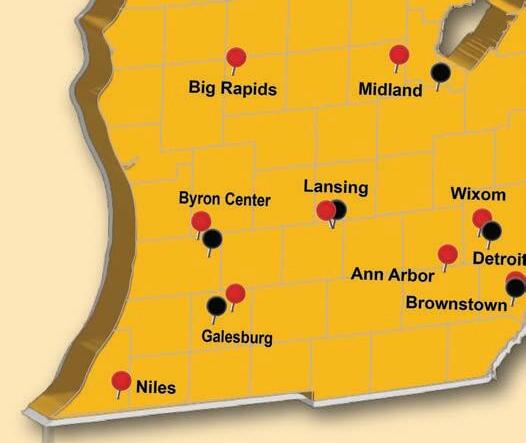




































There are good reasons why the Michigan Contractor of the Year (MCOY) Awards has become such a popular event. Perhaps the biggest reason is that the awards aren’t just about celebrating those contractors who have discovered “the winning formula.” Rather, they’re about improving the overall construction industry where the rest of us live and work.
When the annual MCOY Awards were developed fourteen years ago, the emphasis was on how to improve working relationships between trade contractors and contractors. The underlying intent is to support those who are doing a great job—reinforcing what they are doing while making it desirable for others to follow suit.

The award, by design, is not a “popularity contest.” Instead, it gives American Subcontractors Association of Michigan (ASAM) members an opportunity to nominate and recognize general contractors and construction managers who exhibit best practices, professionalism, and collaboration within Michigan’s trade contracting community. More significantly, the process educates our general contractor friends about how trade contractors and suppliers view the partnerships that are formed through construction projects. Contractors are nominated based on the experiences a trade contractor has with the general contractors they work with.
The goal of the MCOY Awards is to build trusting relationships. The end result is a community of topnotch contractors and trade contractors working as a team—with owners getting everything they pay for and more. ASAM set out to make a difference through action and self-responsibility; the popularity of the MCOY event is evidence that members of the construction industry have the same desire to play at a high level.
ASAM members evaluated nominees for performance in specific categories that are essential to the contractor-trade contractor relationship. Each
member company scored nominees in a confidential, defined process encompassing the following criteria: Bid Ethics & Practices, Safety, Job Site Supervision, Communication, Schedule Coordination, Project Relations, Administrative Procedures, Payment per Terms, and Quality Workmanship.
Administrative Procedures - Clearly defines administrative procedures at the time of contract issue. Provides a contract and replies to RFIs, bulletin quotes, and other change correspondence in a timely manner, and requires all trade contractors to do the same. Does not expect the trade contractor to take unnecessary risks or make assumptions that may later prove false.
Bid Ethics & Practice - Follows and ensures the integrity of the bid process for both publicly and privately bid projects. Ensures consistency as it relates to the scope of work, plans, specifications, and contracts, and provides sufficient time to react to changes noted in addenda, RFIs, and other communications. Does not knowingly push undue risk onto trade contractors. Respects confidentiality of trade contractor quotes and follows fair post-bid procedures by not engaging in bid shopping.
Communication - Questions and concerns are dealt with in a timely manner so as to keep the project moving forward. Regularly communicates candidly, openly, and professionally, shares successes and challenges to all of those involved in the project.
Payment Terms - Clearly outlines and communicates contract payment terms and requirements. Proactively communicates any payment delays. Recognizes the importance of cash flow to the trade contractors on the project. As project progresses, releases retainage in a timely fashion. Fights for reasonable trade contractor payment terms and holds owners accountable.
Project Onsite Supervision - An experienced supervisor who understands effective workflow.
Creates a team approach with trade contractors. Limits delays and wasteful sequencing, stacking, and acceleration. Takes the lead in dealing with site challenges, professionally and in a timely manner, and treats individuals with respect and dignity. Provides sufficient supervisory manpower to meet project needs.
Project Relationships & CollaborationEstablishes a spirit of teamwork in the office and in the field. Handles all team members’ concerns and input in a cooperative, reasonable manner. Sets the tone on the job for all to work together for the good of the project. Manages the owners’ expectations and works to ensure that all trade contractors involved maintain a positive reputation. Executes and promotes collaborative problem-solving techniques.
Quality Workmanship - Establishes applicable standards for quality of work that meet or exceed the industry standards. Utilizes these quality standards as the measuring stick for workmanship quality. Develops work plans that promote quality workmanship. Engages all contractors in the exploration of best practices and innovative solutions as it relates to the construction process.
Safety - Leads the way in creating a safe job site by ensuring each site is clean, neat, organized, and routinely inspected. Provides written standards as it relates to job site safety, creates a job environment that encourages safety education, proactive sitespecific safety planning, and holds all of those involved on a project accountable to follow these standards.
Schedule Coordination - Builds collaborative, realistic, and dependable schedules. Consistently updates and communicates revised schedules with all trade contractors. Understands project flow, trade contractor task durations, and proactively solves road blocks. Effectively sequences the work and holds everyone accountable to meet the project schedule.

Welcome to the thirteenth annual Michigan Contractor of the Year Awards!
I’d like to start by congratulating our eight nominees. Not only do these nominees excel with world-class workmanship, they also excel at building companies that embody the MCOY spirit—strong communication, professionalism, and collaboration.
Tonight’s theme, “Built to Last,” stands as a testament to the resilience, dedication, and collaborative efforts that define our industry. It is a great honor to bring together so many members of the contracting community to discuss and celebrate the enduring impact of our work. The event will undoubtedly serve as an engaging platform for exchanging ideas, fostering partnerships, and exploring strategies to navigate the ever-evolving landscape of construction in West Michigan.
Each year MCOY gives us the opportunity to celebrate the best in West Michigan, but also allows us to highlight how the nominees are building lasting legacies. MCOY facilitates pivotal discussions, and gives us valuable insight into how we can all continue to grow and build relationships, companies, and communities that last!


I am genuinely excited about the prospect of spending this evening with all of you, as we come together to celebrate our nominees’ achievements, share insights, and forge connections that will endure.
Travis KoetjeFounded in late 2012, ASAM joined Ferris State University and USI Insurance Services to create the ASAM Endowment and Scholarship fund. This endeavor is one of the many tactics that ASAM established to support education. ASAM is dedicated to providing students with a direct connection to trade contractors and suppliers in the region. Motivated by a mutual desire to equip students with the knowledge of the contracting trades needed to produce an effective and quality workforce in Michigan, the Ferris State University College of Engineering Technology has formed a close bond with ASAM. ASAM is proud to announce this year’s scholarship recipients:
The ASAM board looks forward to seeing what opportunities lie ahead for Emily and Wyatt as they complete their degrees and begin their careers in the industry.




Congratulations to all our 2023-2024 MCOY nominees! Each of the nominees exhibits qualities that the MCOY Award was founded on—to positively impact the construction industry and community, to improve industry professionalism and innovation, to promote collaboration and safety, and to advance the construction industry into the future.


The ASAM annual MCOY Award is Michigan’s premier industry standard of recognition. Over the last thirteen years, this award educates and provides critical feedback to our general contracting and construction management firms, giving them a pulse on who exhibits best practices, professionalism, and collaboration within Michigan’s trade-contracting community.
As I look back on the inception of MCOY in 2010, I am humbled by the team of dedicated individuals from our ASAM membership who, year after year, put on an amazing program where we can celebrate working with the best of the best. ASAM has shown that by working together, we solve problems, leverage our influence, and provide greater visibility, credibility and prestige for our diverse trades. ASAM has made it a priority to spend an evening together with our peers for networking and to share and benefit from the tips and hard-earned wisdom of business practices. Our “hard hats” off to the nominees, honorable mentions, and the 2023 Michigan Contractor of the Year!
We hope you have an amazing evening with family, friends, and colleagues. Cheers!
Jennifer Sanford MCOY Committee Chair Vice President, ASAM





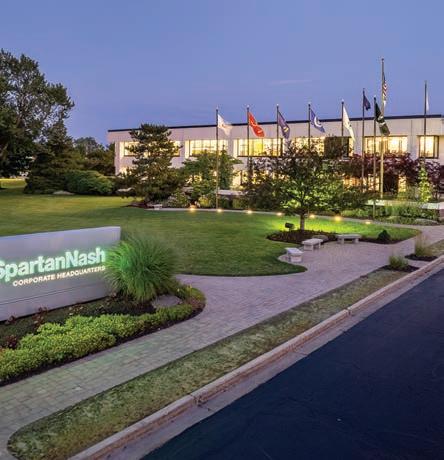




Winner of the 2010, 2013, 2015, 2017, 2019, 2021, and 2022 MCOY Awards
Each year seems to bring a different challenge to our industry. Most companies are blessed with steady work, and at the same time we find ourselves watching the market economy. As inflation and multiple factors in the U.S. and around the world affect our supply chain, the term “long lead” has taken on new meaning.
Disruptions and delays in the marketplace mean that long lead materials arrive with less notice. Our trade contractors have put extra effort into being ready to switch gears quickly to maintain project schedules. We recognize all our trade contractors for their resolute flexibility and effort as they deliver excellence while building with us.
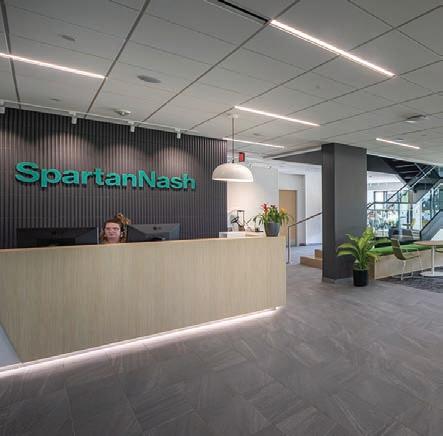

A safety mindset is so important. When we choose to take the time to focus on the here and now, we make space for safety. We can face many unknowns by giving attention to what we can control, and in our industry, we can all control how we communicate, how we relate to each other, how we drive, and how we work each day.
Last year, many of our firms had a part in building the West Michigan Construction Institute (WMCI), which began the legacy of training youth and adults in skilled trades. By working with the WMCI, we are planting the seeds of the next generations of trades who will build for us one day. The future will be bright if we keep our optimism and our commitment to the young generation of trades.
Our West Michigan construction industry has its own culture, created by companies that represent excellence in our marketplace. We are honored to have been awarded the prestigious MCOY for seven out of eleven years. We recognize that we are in good company with you, the general and trade contractors of West Michigan who nurture strong values and a belief in the significance of Michigan Contractor of the Year!







www.andyegan.com

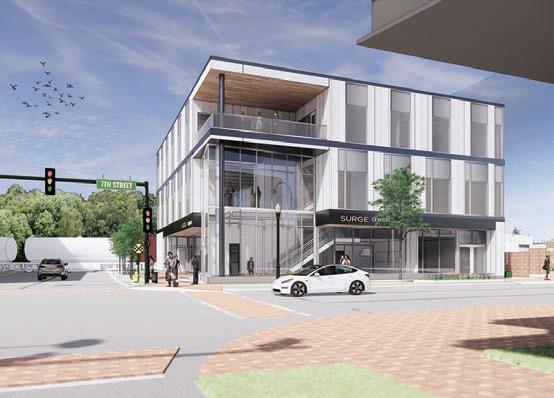



EV Construction has provided a diverse range of services nationwide for nearly 80 years. Our team of over 150 construction professionals serves a wide range of clients from our two Michigan o ces. We pride ourselves on connecting with people; those who work for us, those who work with us, and those who work, worship, or live in the places we construct.

We are proud of our commitment to the safety and well-being of our employees and trade partners on our project sites. EV Construction is nationally recognized for our workplace culture and award-winning safety program. Our team of professionals prides itself on excelling in highly complex environments, which is why we are recognized as a construction leader in acute healthcare, senior living, and manufacturing facilities. Our proven track record of success in these industries is evidenced by client relationships that span decades. We also take great pride in our recognition as one of the nation’s Best and Brightest® Companies to Work For, which we have earned for sixteen years running.

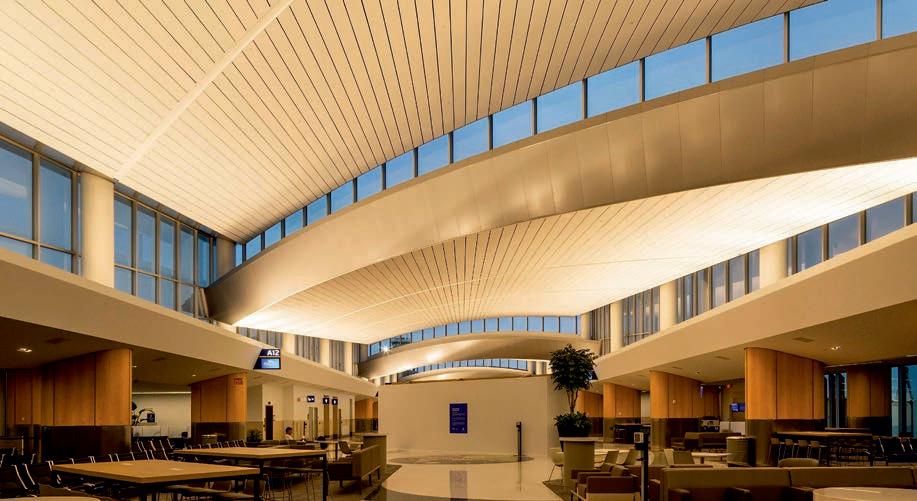
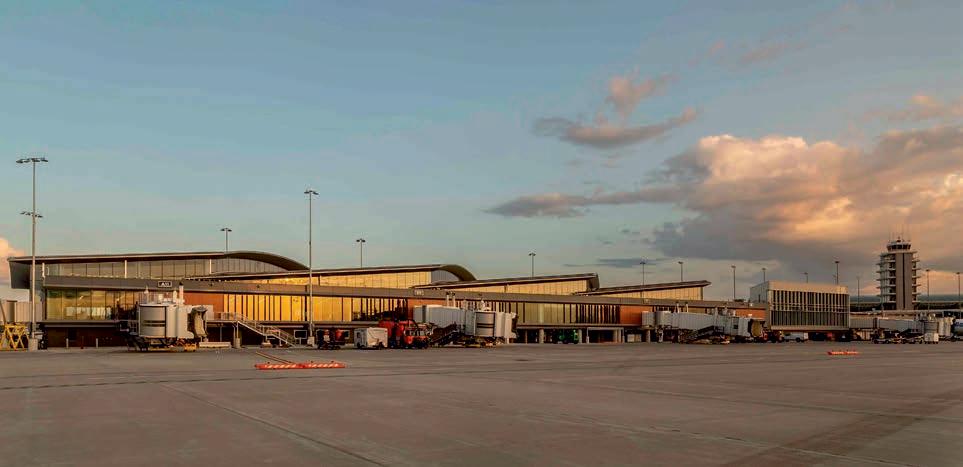
We understand the success of EV Construction is directly related to the success of our trade partners. is award is an acknowledgment of the hard work that our team has put into ensuring our projects are e cient, safe, and completed with a high level of attention to quality and detail. We are honored to be recognized again with a MCOY nomination! Our goal is to create an experience that is di erent from any other construction team. We want to enhance the building experience for everyone involved. From each trade contactor onsite to each client we work for, we strive to stand out from the crowd. We are Built Around People.


For more than a century, Egan has been the mechanical contractor that West Michigan construction managers and general contractors depend on for the highest quality work.
CONGRATULATIONS TO ALL THE 2023 MICHIGAN CONTRACTOR OF THE YEAR AWARDGrand Rapids | Mid-Michigan



For over fifty years First Companies has delivered a full range of real estate, construction, and property management services to West Michigan and surrounding areas. To best meet the needs of their clients, First Companies identifies buy, build, and lease options, assessing the pros/ cons and financial implications of each. This unique multi-disciplinary approach ensures the best space solutions and investment opportunities for their customers in the short and long term.
Early in its history, First Companies gained a deep expertise developing land around the airport and constructing numerous manufacturing, warehouse, and industrial facilities. Since then, the company has become highly experienced in building medical offices and multi-tenant medical/professional complexes, as well as urban mixed-use buildings, retail, office, educational, institutional, and recreational facilities.

As a developer, First Companies works with individuals and investment groups to locate and develop land, as well as assists with financial forecasts, investment returns, and funding options. The company constructs building shells, manages tenant build-outs, and leases available space once the project is complete. Should clients decide construction is their best option, First Companies’ services include ground-up construction projects, building renovations, and office remodels.

Our story began in 1891. Four young engineers in Grand Rapids, Michigan, had a vision to build a great city. eir resumes were written in the lines of their hardened, calloused hands. Our founders cared about people, rst and foremost, and established an employee-owned construction company that eventually became Owen Ames Kimball Co. (or O-A-K, as we call ourselves). Industry trends came and went, marketplace demands evolved, and O-A-K continually transformed.
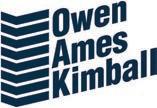





















Today, O-A-K manages the building process, not just the construction itself. We have carried out that vision to build a great city in Grand Rapids, and have expanded into Kalamazoo, Michigan, Southwest Florida, and Colorado. At our core, we are culturally humble and driven. We imagine if we met those four young engineers today—132 years later— they would tip their hats.





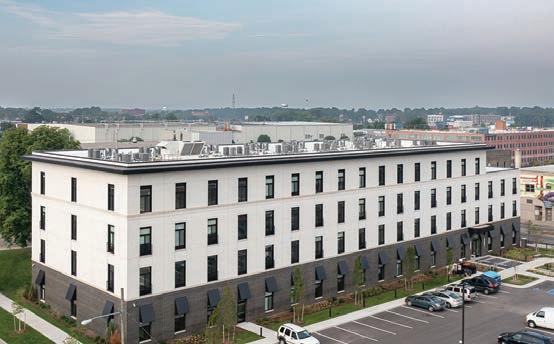


Originally from the Netherlands, Earl Beckering Sr. worked his way to the United States of America as a carpenter aboard a ship. He eventually settled in Grand Rapids, Michigan. In 1933, the young entrepreneur founded Beckering Construction Company. From the beginning, Earl established a reputation for a strong work ethic, personal service, quality cra smanship, and a hands-on management approach. In honor of Earl Sr.’s legacy, these qualities continue to be the trademark of Pioneer Construction.
In 1962, under the leadership of Beckering’s son, Earl Jr., the company name was changed to Pioneer Construction to re ect the innovative attitude and expanding services of the rapidly growing rm. In 1971, Earl’s son, Tom, took the reins of the company. Under his leadership, Pioneer expanded to become one of the largest full-service construction companies in the Midwest.





Now, in the fourth generation of family ownership, Tim Schowalter has positioned the company as a recognized leader in sustainable building and construction technology while maintaining the heritage of quality construction delivered on time and within budget. As the prime construction employer in West Michigan, Pioneer has a multi-talented workforce of over 200 people. Many team members have worked with the company for over een years. Pioneer’s strength is in the skilled hands and creative minds of their team members. Pioneer continues to build on the qualities that the company was founded on while remaining at the forefront of innovation in an ever-changing industry.






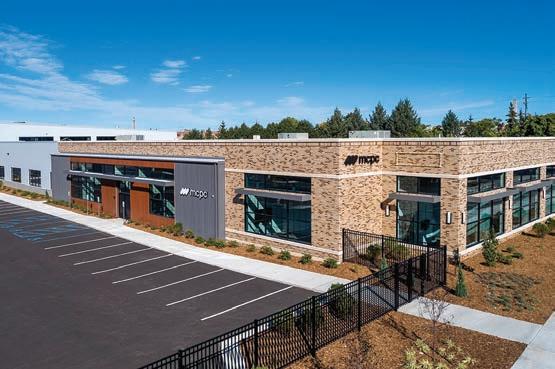



For more than thirty years, Rockford has been serving the commercial, multi-unit, educational, industrial, healthcare, and retail markets throughout Michigan. From small-scale renovation work to large, new construction e orts, Rockford tailors its approach because each project is as unique as the community it serves. And as a company o ering construction management, development, and property management services, Rockford brings a holistic perspective as owners, builders, and operators, rooted in safety and a commitment to cra smanship.
As an industry leader, Rockford values the talents required to deliver quality cra smanship. West Michigan’s trade contractors are experts in their elds who do what it takes to get the job done right, every time. At Rockford, we share this mentality. We choose to do what’s right over what’s easy. at’s why we have a dedicated safety team that invests in site-speci c planning, training, and onsite resources. With safety always at the forefront of our minds, we challenge ourselves to be leaders on our jobsites and in our communities. Because nothing is ever more important to Rockford than getting our teammates, partners, and clients home safely to their families.


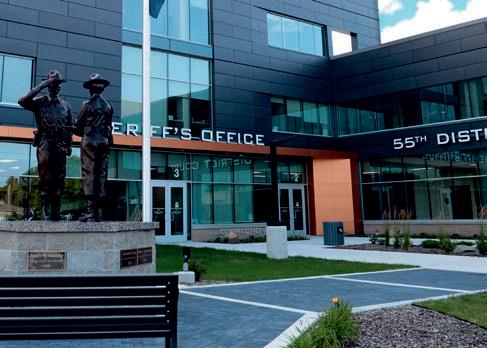




We’ve been committed to our state for over three decades, working with local trade contractors to complete projects of all sizes and scopes. Our work is not possible without these relationships. Each of these partners contributes their expertise to help us create spaces that are beautiful, sustainable, welcoming, and vibrant. Working together, we’ve built a proud history of tackling the tough stu , using fresh ideas and innovation to solve problems. at spirit lives on today. With Michigan trade contractors on our team, we are able to live out our vision, together—Building a Better World.



Your efforts have been instrumental in propelling our industry forward, and we thank you.




Erhardt Construction, founded in 1962, is a general contractor, construction manager, and design-builder in West Michigan. Providing the best construction experience for our clients has been the firm’s foundation since its beginning and continues to be our primary goal today. Our reward is the client’s reaction when they see the connection between a vision, a design, and a completed space.



For over sixty years, Erhardt has constructed the buildings that define cities and regions. We’ve also enhanced our area’s exceptional quality of life with projects of a quieter nature, such as college and university facilities, churches, senior living centers, and executive-level luxury homes. These projects are a testament to Erhardt’s level of quality. Our experience is broad and our approach to every project produces results tailored to our clients’ vision and needs.


Erhardt’s focus is client centered. We first listen intently to the client’s needs and expectations, then take the initiative to respond with actions that will meet them. Our approach is that of a team player taking a proactive role. We give candid input promoting creative constructive dialogue, which results in a successful project.


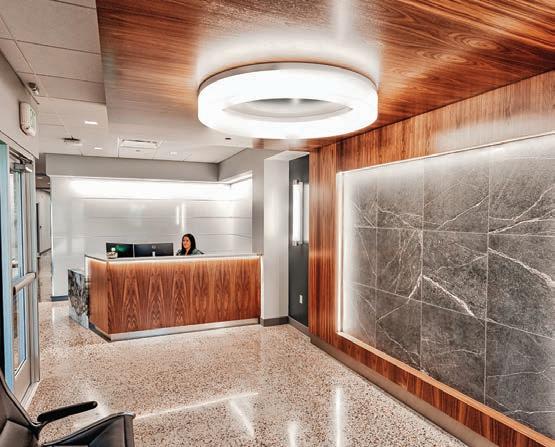

Winner of the 2010, 2013, 2015, 2017, 2019, 2021, and 2022 MCOY Awards
We share the MCOY achievement with our trade contractors because we are not alone in building remarkable buildings. Year after year, our West Michigan construction industry can be proud of professionals that portray values that allow all of us to triumph. We can stay ahead if we stay connected within our contracting community. We are passionate about construction, and the people who build.

In the last few years, the ground has been shifting in most industries including construction. Trust and faith have helped us and our trades to forge through. Our work is steady; we are busy and at the same time find ourselves monitoring the market and investing in a future labor force.
Disruptions and delays in the supply chain cause long lead building materials to arrive with short notice. Our trade contractors anticipate and adjust to protect our project schedules. We recognize all our trades for their resolute flexibility and determination while building with us. Excellence achievable in our marketplace because of our subcontractors!
Our culture at Dan Vos Construction Co. is based on a tagline, Building for Life, which is to be the most respected contractor and design-build firm in West Michigan. We believe that the only way to truly grow is to build trust, with our trades and employees. The MCOY is a living culture among the people who make up our company and work together. From each of us at Dan Vos Construction, thank you for building an industry where we can all continue to grow, learn, and thrive.
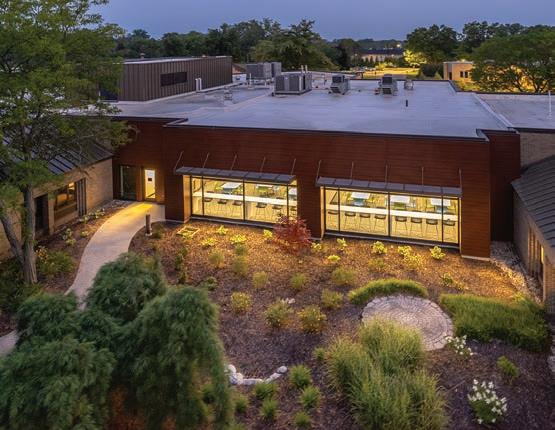
DANVOSCONSTRUCTION.COM


Striving toward its core purpose of helping to “unite great people in great achievement,” The Christman Company—a century-old builder—is privileged to team with customers, trade contractors, design teams, and other partners in constructing great facilities solutions throughout West Michigan and beyond. Founded in 1894 with its West Michigan office established in Grand Rapids in 1991, Christman, in conjunction with its affiliates, offers a full complement of professional services including construction management, general contracting, design-build, real estate development, program management, and uniquely customized planning, analysis, and consulting services.
Counted among West Michigan’s premier contractors, Christman is currently ranked #85 on the 2023 ENR 400 list of the top 400 contractors nationally, and #56 in the list of Top 100 Construction Management-at-Risk firms, and #66 on the 2022 ENR list of Top 100 Contractors by New Contracts. The Christman Company is consistently recognized yearly as one of the Top 25 Contractors in West Michigan by the Grand Rapids Business Journal. Recent and current projects include renovations and additions for numerous K-12 partners including Wyoming Public Schools and Muskegon Public Schools, completion of Concourse A at the Gerald R. Ford International Airport, new construction of the Corewell Health New Ambulatory building at the Michigan Street Development, Corewell Health ICU, and complete renovation of Dunbar Hall at Western Michigan University.

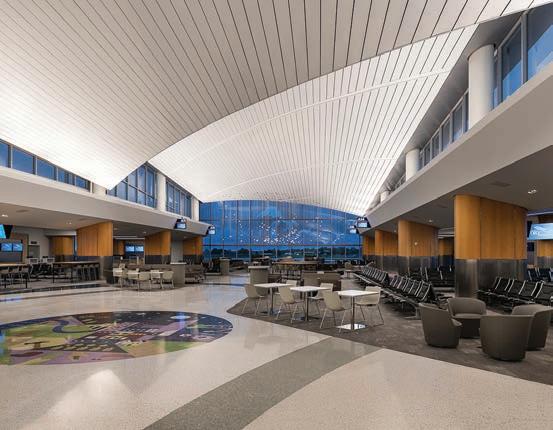


Christman team members enjoy collaborating with the company’s trade contractor partners to advance industry innovation and best practices and continue to achieve outstanding results, including focus on building information modeling (BIM) and lean construction techniques, value management practices, sustainable design and construction, and partnership-driven safety standards that send everyone home safely each night. Through its “Be Constructive” program of community giving and volunteerism, Christman supports local organizations, including Habitat for Humanity of Kent County, West Michigan Construction Institute, Gilda’s Club Grand Rapids, D.A. Blodgett St. John’s, Communities Overcoming Violent Encounters (COVE), Ele’s Place, and others. For more information about Christman, visit www.christmanco.com.
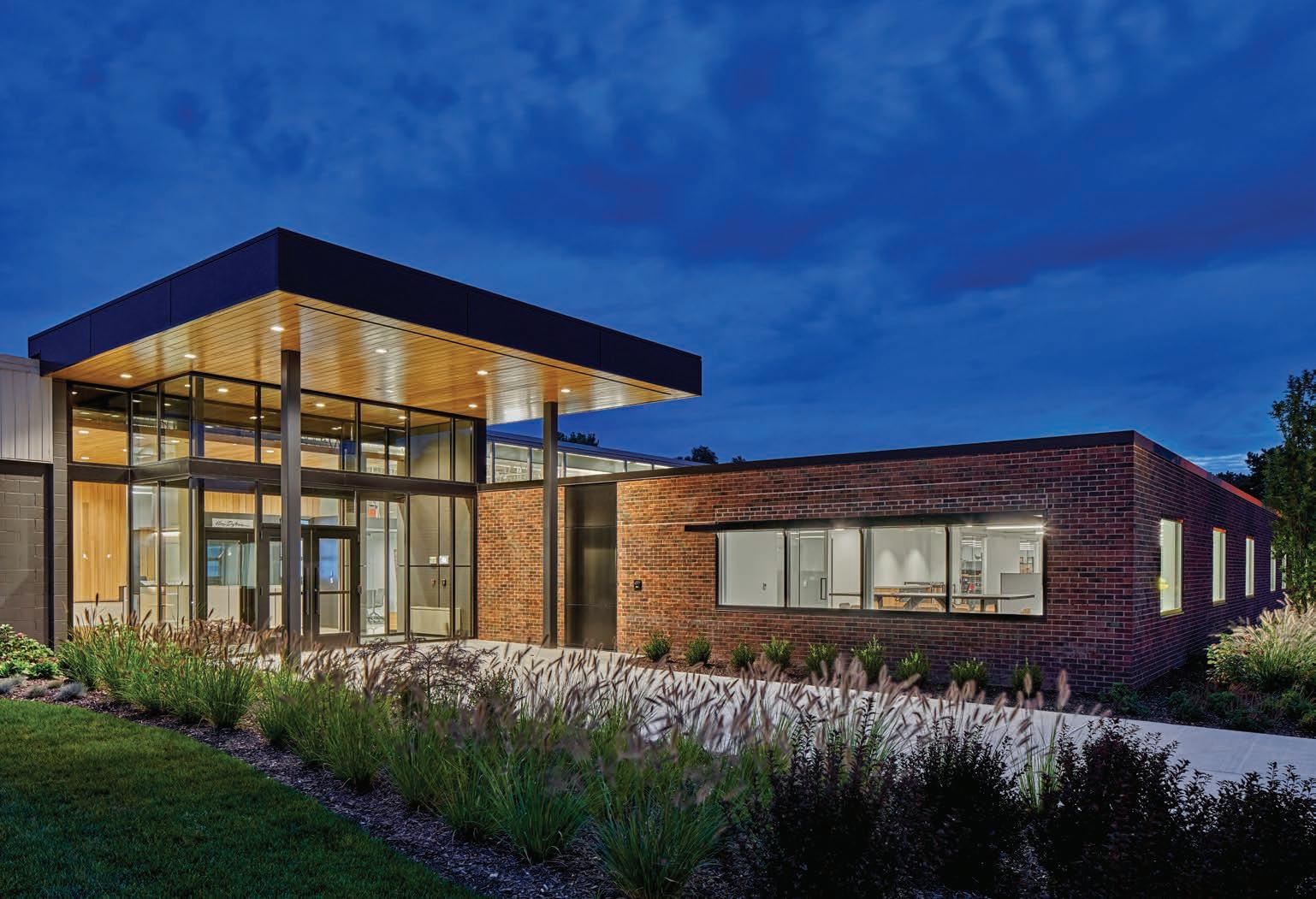
Monthly ASAM meetings empower our members with information about current developments, issues, and practices. In addition to networking opportunities, these meetings cover topics from the latest local news to emerging national trends. Monthly meetings are typically held on the second Wednesday of the month. Any employee of a member company is eligible to register, and in some cases bring guests. Visit our website for the most up-to-date list of events and registration information—ASAMichigan.net. Please join us!
Dan Hall, Committee Chair | Email: dhall@agm-michigan.com
September – Think Tank Meeting with ASA National
November – Construction Advancement Forum with Veneklasen Construction
January – General Membership Meeting – Safety
February – General Membership Meeting – Economic Update with Dr. Paul Isley
March – Construction Advancement Forum with Triangle Associates
April – General Membership Meeting – Jake Hall
May – TBD
June – ASAM & MCOY Nominees Networking
General Member Meetings (GMM)
These regularly scheduled meetings, open to the entire membership and guests, cover timely topics and general-interest issues such as changes in the local economy, recruitment tips, safety standards, HR best practices, and more.
Business Practice Interchange (BPI)
BPI is an event offering ASAM members the opportunity to come together and discuss contract language, lien process, and many other critical topics. These sessions are closed door and completely private, so members can have candid conversations about their experiences with clients and others.
Construction Advancement Forums (CAF)
CAFs invite a local general contractor to speak and share with ASAM members. The contractor typically introduces new practices, discusses industry processes, and provides insight on creating stronger working relationships.
Created in 2017, the ASAM Safety Committee’s mission is to provide information, guidance, and access to training resources to ensure that our trade contractors are up to speed on best practices. To accomplish this, ASAM formed an alliance with MIOSHA to promote a mutual commitment to protecting the health and safety of workers, particularly smaller contractors. ASAM Safety Committee benefits include:
FREE job site walkthroughs with general contractors on a variety of job sites—led by a MIOSHA construction safety consultant. Attendees experience a broader, more holistic view of how one aspect of job site safety impacts another.
Next walkthrough: Tuesday, November 7, 2023
Quarterly meetings include a general discussion on the safety needs of our members, observations, and training. They also provide an opportunity for attendees to brainstorm ideas on how to effectively work together to meet our safety goals.
If you’re interested in joining the ASAM Safety Committee, or want to learn more, visit: asamichigan.net/safety or send an email to: info@asamichigan.net
JENNIFER SANFORD | Phoenix Interiors RYAN KALMAN | The Bouma Corporation SETH WEHNER | SW MGT
Through our recent merger with Doeren Mayhew, we’ve brought the power of two construction accounting firms together to help make your business stronger.

Built upon a foundation of delivering tailored industry solutions, our unified Construction Group strengthens our commitment to help contractors identify opportunities, create long-term strategies, and overcome operational and financial challenges every step of the way. Our experts are here for you. www.beenegar ter.com
Congratulations to all of the 2023 MCOY Award nominees!



Available for Apple and Android phones & tablets.
Scan the QR code or visit: ASAMichigan.net/app

Be sure to grant the proper permissions once you’ve installed the app. iOS users will receive the following prompts:



1. Location: ‘Always Allow’










2. Enable notifications: ‘Notify Me’







3. Send notifications: ‘Allow’

Android users will receive similar prompts.

2022-2023 CONTRACTOR OF THE YEAR DAN VOS CONSTRUCTION COMPANY


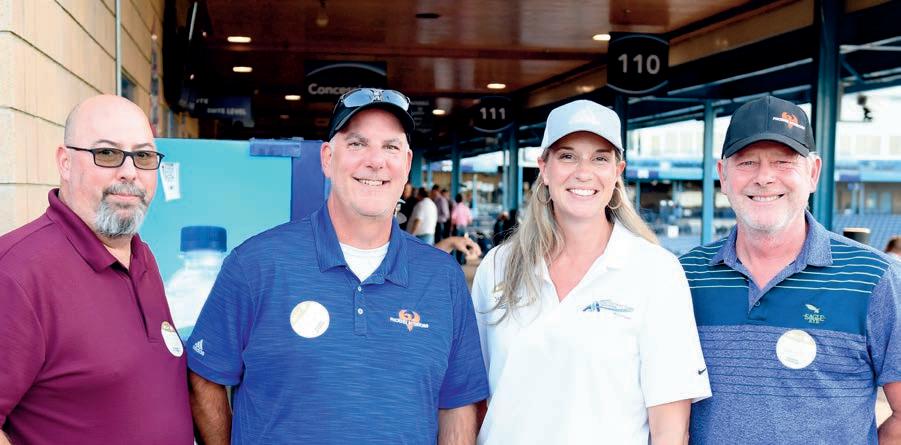





2022-2023 1ST HONORABLE MENTION EV CONSTRUCTION
2022-2023 2ND HONORABLE MENTION PIONEER CONSTRUCTION















Ranked by 2022 total revenue
32nd St. SE
Rapids 49508
(616) 452-5900 f 452-8525
Holland Home - Raybrook
Raybrook St. SE
Rapids 49546
(616) 235-5704 f 235-5680
Beacon Hill at Eastgate
Boston St. SE
Rapids 49506
(616) 245-9179
Stonebridge Manors
49534
(616) 791-9090 f 791-6722
847-4242 f 846-3457
49404
(616) 997-9253 f 997-7234
Rose Garden 3391 Prairie St. SW Grandville 49418 p (616) 538-1914
sunsetcommunities.org/communities/rosegarden/
If there’s one thing that’s abundant at Holland Home, it’s peace of mind. With a full continuum of care for residents from Independent Living to Assisted Living, Skilled Nursing, and the only Positive Approach to Care®-accredited Dementia Care services in the state, residents can receive the care and support they need as they move through the aging journey, even if they outlive their financial resources. Residents at all levels of care have access to our award-winning Vibrant Living model, which provides a range of resources, activities, and experiences that help aging adults stay physically, mentally, spiritually, and socially engaged.






For more information visit hollandhome.org or call (616) 643-2730.



































housing for ages 62 and older, community room, computer lab, on-site food pantry, Meals On Wheels café, social worker
nonprofit licensed assisted living, spiritual care provided, income-based rate program available to qualified
Mount Mercy Apartments
& 1511 Bridge St. NW
Rapids 49504
(616) 235-2843 f 235-2851
Terrace Apartments
Leonard St. NE
Rapids 49505
(616) 235-2890 f 235-2876

Hume Home of Muskegon
1244 W. Southern Ave. Muskegon 49441 p (231) 755-1715 f 755-3155

housing for ages 55 and older; ages 55-61 must have a disability to receive rental subsidy; food pantry, café, social worker
apartments for ages 55 and older, ages 55-61 must have a disability to receive subsidy; on-site food pantry, cafe; shopping adjacent
Crain's Grand Rapids Business list of top area senior residential communities, ranked by 2022 total revenue is the most comprehensive available. The list is based on responses to Crain's Grand Rapids Business surveys. Crain's Grand Rapids Business defines "West Michigan" as Allegan, Kent, Muskegon and Ottawa counties. Crain's Grand Rapids Business surveyed 159 senior communities; 25 returned surveys and 20 are listed. To be considered for future lists, email danielle.nelson@crain.com. DND = did not disclose

LIST STORE: Download this list now at crainsgrandrapids.com in Excel or PDF format. | The Book of Lists and other lists are also available.


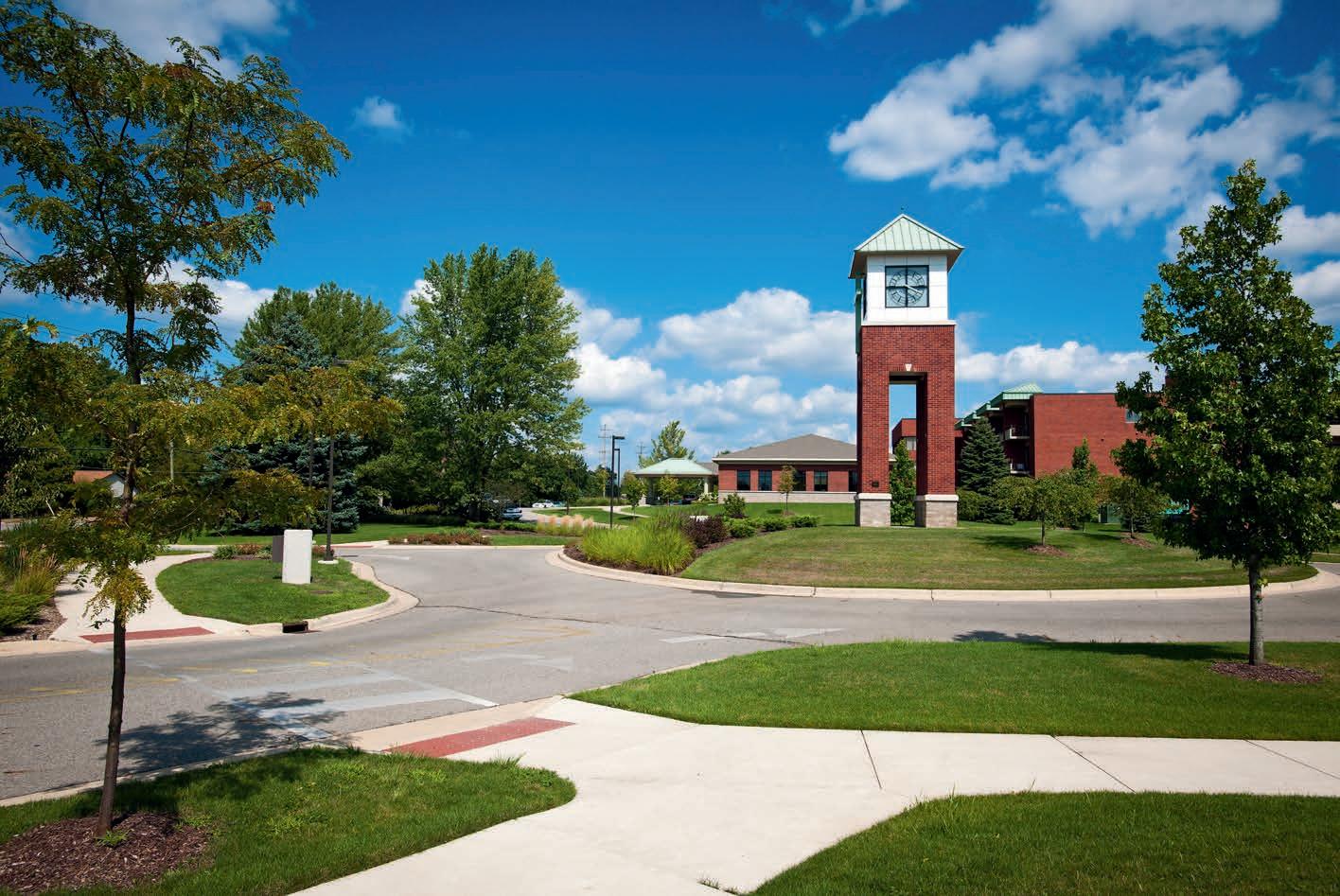







Ranked by 2022 total West Michigan revenue
Raybrook St. SE, Suite 303
Rapids 49546
(616) 235-5100 f 235-5050
Cedar St. NE Grand Rapids 49503 p (616) 486-3900 f 486-3999 corewellhealth.org
Atrio Home Care 2100 Raybrook St. SE Grand Rapids 49546 p (616) 235-4663 f 356-4967
provided in homes, facilities, hospitals and at Trillium Woods, our hospice in-patient facility; complementary therapies including massage therapy, aromatherapy and more
speech
occupational therapy, medical social work, private duty care, telehealth services and
including nursing services; physical, occupational and speech therapy; medical social services; registered dietitians and more Health Care Associates 3101 Prairie St. SW Grandville 49418 p (616) 531-9973 f 531-3440 healthcareassociates.net
Crain's Grand Rapids Business list of top area home health care and hospice providers, ranked by 2022 total West Michigan revenue, is the most comprehensive available. Crain's Grand Rapids Business defines "West Michigan" as Allegan, Kent, Ottawa and Muskegon counties. Crain's Grand Rapids Business surveyed 58 agencies; 6 returned surveys and 5 are listed. To be considered for future lists, email danielle.nelson@crain.com. DND = Did not disclose
LIST STORE: Download this list now at crainsgrandrapids.com in Excel or PDF format. | The Book of Lists and other lists are also available.
Grand Valley State University officials say heightened recruitment efforts are paying off as they welcome the school’s largest and most diverse incoming class of 4,974 students this fall, as well as an increase in overall enrollment.
GVSU achieved its largest freshman class in its history by reviewing and analyzing its previous recruitment efforts to identify gaps, said B. Donta Truss, vice president for enrollment development and educational outreach.
“There were some students that we had been leaving on the table, and we felt that we could go and find those students and work with them to get them in the education pipeline,” Truss said.
Truss and his team created a strategy called “take our backyard,” which aims to attract college-age students in the greater Grand Rapids area.
“We doubled down by adding more recruiters and making sure we visited local schools more,” Truss said. “We’re also making sure we send people that look like the students at the schools (they are going to) to build strong relationships, but more importantly so those learners could see somebody that looked like them that came from a similar background and see them be successful to see that they can be successful themselves.”
The number of incoming students at GVSU is up 24% from last fall’s incoming class, and includes just under 1,400 students of color, or 28% of the students. The enrollment statistics for this year’s incoming class also broke previous records for the university in the number of African American or Black students, which is up 52%.
First-year Hispanic/Latino student enrollment is up 42%, and the number of first-generation students is at 2,149.
To prepare for GVSU’s most diverse incoming class, the university is working to hire more student success coaches who share in the diversity and come from
aware, and to make sure that we’re meeting students where they are and that we’re sharing all the resources that we have with them,” Truss said.
GVSU’s overall enrollment is also up this fall by 3% from last year, at 22,269 students. The university’s total enrollment peaked in the fall 2016-17 academic year at 25,460 students. The student body this fall contains the university’s largest ever number of students of color at 23%, and highest number of international students at 18%.
Affordability also is a key part of bringing in a diverse class of students, including first-generation students, and GVSU has made an effort to make sure counselors and advisers help students navigate financial aid, Truss said.
similar backgrounds. GVSU also is working to ramp up mental health services for students, for which administrators have seen a growing need since the pandemic, Truss added.

“We’ve asked all of our team members to ramp up their services and to be more culturally
Colleges and universities in Michigan are combatting several obstacles in their recruiting efforts, including the state’s declining population. Michigan’s population has declined by about 43,200 people since 2020, and the city of Grand Rapids lost about 843 people in 2022, according to U.S. Census Bureau data.
Meanwhile, overall college enrollment has been declining in Michigan and nationally. Total undergraduate enrollment at de-
gree-granting, post-secondary education institutions in the U.S. has steadily declined since 2010. Overall undergraduate enrollment dropped 15% in the U.S. from fall 2010 to fall 2021, nearly half of which occurred during the COVID-19 pandemic, according to the National Center for Education Statistics.
Citing data from the National Student Clearinghouse Research Center, Bridge Michigan reported in May that Michigan’s college enrollment declines were worse than the national average.
At a press conference last month, GVSU President Philomena Mantella said she attributes GVSU’s freshman enrollment gains to the university’s Reach
Higher 2025 strategic plan, an ongoing effort to grow enrollment despite the national and statewide trends.
“The biggest problem was not the resources, it’s the belief. Because the public narrative is growth is going to be impossible, growth is going down,” Mantella said. “But look at the participation rate of people who are not in education today that should have that opportunity. Look at the opportunity to scaffold education that is not complete, and for Michigan to be a destination for your education. We have resources — not all we need, but enough to see growth and follow it strategically and believe in what we are able to do as an institution.”
The number of incoming students at GVSU is up 24% from last fall’s incoming class, and includes just under 1,400 students of color, or 28% of the students.

















 By Kate Carlson
By Kate Carlson






The developers behind a 54unit assisted living facility that has been in the works since before the pandemic plan to break ground at the end of this month on Grand Rapids’ southeast side.

MoTown Square has scheduled a ceremonial groundbreaking for Oct. 20, with construction expected to start the next week on five connected parcels that will make up the project’s affordable assisted living development. Nonprofit LINC Up and MoTown Square Development, founded by Maurice Townsend who currently resides on the project site at 240 Hall St. SE, are developing the proposed 50,800-square-foot building.
Townsend’s own residence and a vacant duplex that he owns will be demolished to make way for the nearly $18 million project.
“I’m excited because the Third Ward has been struggling for some time, and this being an almost $18 million project, we’re excited to see this happen and for the community to have a beautiful new building,” Townsend said.
“My hope and goal is this will spark other interest from other investors that will help make this a more walkable community.”



Townsend’s parents were involved in working at and operating assisted living facilities for about 20 years, and his mother still owns and operates a pair of facilities in Grand Rapids that house about 30 residents overall.

“When I was going through my undergraduate education, I had the privilege to work with my parents and explore the different sides of the business,” Townsend said. “I really experienced the needs they have, and after a while, you become family with these residents and form loving relationships.”
The project cost to construct the four-story facility has gone up since it was initially proposed because of rising costs of construction, labor and materials, which also have led to delays, Townsend said.
The development team “closed the gap” on the higher costs, and the project also received several grants, including a $990,000 revitalization and placemaking grant from the Michigan Economic Development Corp. As well, the development is receiving Low Income Housing Tax Credits, as well as project-based vouchers from both the Grand Rapids and Wyoming housing commissions, Townsend said.
The apartment units in the facility are intended for residents earning between 30% and 60% of the area median income.


Project plans also call for community space with a dining room, as well as a workout room, bike room and hair salon for residents. Elders Helpers and Meals on Wheels also will take space on site to provide residents care tailored to their needs, Townsend said.
The developer aims for the project to be fully leased and operating by April 2025 or sooner.




Grand Rapids-based TowerPinkster is serving as the architect for the development, while Orion Construction, also of Grand Rapids, is the general contractor. Portage-based Intrepid Professional Group Inc. will serve as the property manager of the facility once it is completed.










Townsend also is working with his mother, Marva Townsend, to secure funding to renovate Living Well at 1001 Lafayette Ave. SE, one of the assisted living centers she operates in Grand Rapids. The facility has the capacity for about 60 residents but currently is closed for renovations.
Townsend also remains in the early stages of developing another housing project on Grand Rapids’ southeast side. He recently held a public engagement session where he announced plans to construct a four-story, mixed-use project with 76 apartment units next to the Great Giant Supermarket.
“My passion (of working in the assisted living space) is because these people need help,” Townsend said. “We can’t just say we’ll put them in a home, we really need to take care of our elderly.”
w Cheryl Kuch, senior consultant at consulting firm Rehmann
w Kristin Spykerman, chief clinical officer for Network180, the community mental health authority in Kent County
w Kiran Taylor, M.D., chief medical officer at Hope Network
come out of the pandemic has been the increased level of attention to mental health, which has led in turn to increased awareness of resources in communities, health care settings and in the workplace.
As businesses continue to bounce back from the pandemic, they’re placing a special focus on mental health, particularly as employees begin returning to the office in increasingly hybrid work schedules.
While employers have shifted focus to offer more benefits, bonuses and stipends to support employee wellbeing, many executives are left wondering what mental health care should look like in work environments, how they can best support their teams, and what they can do to determine employees’ true needs.
Those were among the themes discussed on Sept. 13 at the Crain’s Grand Rapids Business Power Breakfast event on mental health in the workplace. The event, which was moderated by The Employers’ Association President Jason Reep, featured a panel of local leaders in human resources and mental health, including:
w Scott Halstead, Ph.D., vice president of outpatient and recovery services at Pine Rest Christian Mental Health Services


The Community Health Needs Assessment (CHNA) for Kent County in 2020 revealed that 47% of residents believed that their mental health worsened during the COVID-19 pandemic.


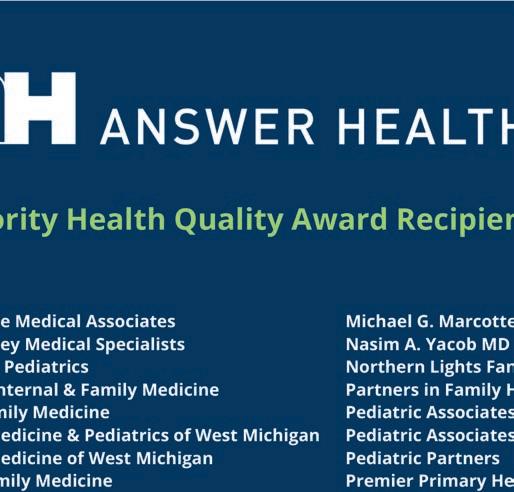
One of the downsides for employers in the pandemic recovery period has been a lack of employee engagement, according to Kuch.
“The first nosedive in engage-
“I think that’s a reflection of change,” Halstead said. “The fact that we can be here today (to) have this discussion, that people can say, ‘I was talking to my therapist the other day’ and people don’t go, ‘Ooh, you got a therapist’ — I think that’s a shift over the last five years. It’s not that we’ve eliminated stigma, but it’s better than it was by a lot.”
The surge in workplace mental health awareness has brought with it a host of new offerings and pro-
“If you’re a leader, (an) HR professional, even a colleague, and you’re really serious about impacting the mental health of your workforce, take a look at your organizational culture,” Kuch said. “Take a look at how your engagement within your organization is: What’s your culture like?”
According to a 2023 survey by the Society for Human Resource Management, 60% of employees surveyed worldwide said their job had the biggest effect on their mental health. In the same survey, one in three workers said their manager fails to recognize the effect they have on their team’s mental wellbeing, and 70% said they want their company to do more to support mental health.
“If you want to make a difference, programs are really great, but (it needs to be) in combination with taking a close look at the way you’re leading the organization and how your supervisors and managers are interacting or not with their team,” Kuch said.
be while they’re at work, they’re not going to be focused 100% on the work they’re trying to do,” Taylor said. “I encourage us to think broadly when we think about benefit offerings and how to structure mental health benefits at work.”
At the same time, companies offer benefits like employee assistance programs (EAP) that haven’t been well communicated. As employees increasingly tailor their job searches to their mental health needs, they’re looking for employers that offer EAPs or make team mental health a priority, and businesses stand to benefit from broadcasting their offerings to current and potential employees.

ment (was) during COVID, in the middle of 2020, and it has been down, down, down ever since,” Kuch said. “I’ve been very concerned about this even since the beginning of 2023, because I was very hopeful we would certainly see it pick up a little bit (but) not so much.”
However, one silver lining to
grams to help re-engage employees and demonstrate employers’ care for the wellbeing of their teams. Panelists said many employers are leaning into employee mental health, such as with stipends for employees to spend on relaxation spaces and the offering of wellness days.
Taylor said part of the work to strengthen workplace mental health starts with being aware of real employee needs and tailoring offerings accordingly. For example, child care can contribute to employee stress and negatively affect productivity.
“If our employee is thinking about where their child is going to
“Our employees coming in are younger and younger with less and less experience in the workforce by the time they get to us,” Spykerman said. “If they don’t feel confident in the work that they’re doing, that can lead to a host of issues around anxiety, around work and depression uncertainty. I do think we’re seeing more younger workers utilize (EAP) services.”
The next Crain’s Grand Rapids Power Breakfast is scheduled for Nov. 8 at Frederik Meijer Gardens and will feature a conversation with Grand Action 2.0 Executive Director Kara Wood, as well as a panel of experts discussing the commercial real estate outlook for 2024.
employers play a crucial role in their workers’ wellbeing
By Abby Poirier
“If our employee is thinking about where their child is going to be while they’re at work, they’re not going to be focused 100% on the work they’re trying to do.”
Kiran Taylor, M.D., chief medical officer at Hope Network

New research from the American Immigration Council was released recently by the Grand Rapids Chamber of Commerce, in collaboration with the Kent County Welcome Plan, highlighting the population growth trends and economic contributions attributed to immigrants in Kent County and West Michigan.
The data shows that from 2014-2019, the population in Kent County increased by 5.2%, with more than 38% of that population growth resulting from immigrants relocating to this area. In 2021 alone, immigrant households in the county earned $2 billion in income, paid $318.8 million in federal taxes, and nearly $174 million in state and local taxes. Additionally, they contributed $192 million to Social Security and nearly $48 million to Medicare. The data also shows that while immigrants made up 8.9% of the county’s total population in 2019, they represented 10.5% of our employed labor force. That’s an important pool of workers for staff-starved companies. This economic data tells a powerful story, one that should be of interest to everyone in the county.
force data is compelling, there’s a human side of the equation that social agencies encounter on a daily basis that often goes unnoticed. What many people don’t realize is that Michigan is the fifth-largest refugee resettlement state in the nation, and West Michigan is one of the largest resettlement regions within our state. An influx of immigrants, refugees and new Americans to this area means a greater need for support services.
students to integrate into the educational and cultural systems in their respective communities. It’s a constant challenge for all involved. By comparison, imagine moving to a foreign country with your schoolage children, with little or no money in your pocket, no place to live and no other family living nearby.

filled with frustration, discrimination, pain and anguish – yet when they arrive here, they are often confronted with new difficulties no one should have to encounter.
What can you do to drive change? First, review the recent report from the Grand Rapids Chamber and Kent County Welcome Plan. Beyond that, welcome refugees and new Americans to your neighborhood. Be gracious as they integrate into a new community. Support the addition of multilingual services in your area. Volunteer with local refugee and immigrant agencies and provide financial contributions to those agencies. Hire individuals with immigrant and refugee backgrounds. And if you’re a business owner who needs support navigating the recruitment and retention of immigrant employees, contract with organizations like Refugee Education Center that can assist your team with culture competency training.
While this positive economic and work-
At the Refugee Education Center, our staff and volunteers are committed to providing academic support to refugee children as they resettle in West Michigan. We serve students from birth to 24 years, helping them move through their educational journey. Additionally, our refugee navigators assist parents and other relatives of the
It would be a daunting transition for anyone. That’s why we and other local agencies remain committed to supporting the refugees coming to this region, giving all an opportunity to thrive in their new home.
While a strong and welcoming foundation exists here for incoming refugees, we still have work to do. Just like many minority populations in the U.S., refugees and new Americans face inequities and societal disparities. Their path getting to the U.S. is often
Welcoming refugees and other immigrants to our region comes with many benefits. It makes us a more diverse and appealing destination. It grows our population, increasing tax revenues for local municipalities, creates a potential stream of new workers for employers and gives us greater political standing in the eyes of our federal government. Most of all though, it reflects the spirit of who we are – a welcoming and compassionate community that is committed to the prosperity of all those who call West Michigan home. COMMENTARY
Michigan’s third grade reading scores have fallen once again, perpetuating a rolling disaster with grave consequences for businesses’ ability to compete — and for a generation of our children.
The question is: Will we treat this as the wakeup call it is, with a bold response to one of the most significant challenges of our time?
Michigan’s employers already struggle to find skilled and educated talent. Given our dwindling and aging population, the schoolchildren of today represent the best hope for a more prosperous tomorrow, when employers have the talent they need, and individuals thrive in their careers. But those hopes will be out of reach if we fail to provide students with the fundamental skill of reading. Unfortunately, our responses so far have failed to produce results. TalentFirst documented this recently with publication of its statewide dashboard of building-level reading scores, showing persistent underperformance at every economic level.
Despite significant state investments — increases TalentFirst endorsed — the Mich-

igan Student Test of Educational Progress scores for 2022-23 showed third grade reading proficiency at its lowest since the M-STEP was adopted in 2015. Just 40.9% of third-graders scored proficient or advanced — meaning nearly 60% of our kids entered fourth grade this year unable to read at the level they need to succeed.
It will be tempting to argue this is another casualty of the pandemic, with its shuttered schools, illness, and an ongoing absenteeism crisis. We will stipulate COVID-19 was devastating. Pervasive learning loss was why the federal government poured relief funding into education — including more than $6 billion for Michigan districts.
But the causes are irrelevant to the children we are leaving woefully unprepared for life. Children who read poorly are more likely to drop out of school and face lives of unemployment, poverty and crime.
According to the National Assessment of Educational Progress in 2022, Michigan ranked 43rdamong the states for fourthgrade reading, down 11 places from the already poor showing in 2019. This has dire
implications for our talent needs — but our children are paying the greatest price for this race to the bottom.
It is time for an urgent response. The good news is that many other states know what works.
They have enacted reforms that emphasize scientifically based curricula and practices. Mississippi, which ranked 49th for NAEP fourth grade reading scores before reforms a decade ago, climbed to 21st by 2022. By comparison, Michigan allows a patchwork of curricula and practices, many now discredited. In a 2022 EPIC survey, Michigan K-5 teachers reported using 464 different English Language Arts curriculum resources; 48% used materials not aligned with the research on literacy instruction.
We are encouraged by the state’s recent investment in LETRS training for teachers and other strategies. But we must do more.
Before publishing our dashboard, we engaged with researchers, parents, school board members, superintendents, principals, literacy coaches and teachers. As a result, we learned:
w Schools should evaluate reading curricu-
la and replace it with evidence-based curricula if not already present.
w Teachers should be supported in selecting evidence-based curricula.
w School leaders should provide teachers with high-quality coaching and ongoing professional development aligned to research-supported literacy instructional practices.
K-12 leaders tell us literacy does not appear to be a priority in communities. Few parents show up to parent/teacher conferences to discuss their child’s academic progress or school board meetings asking about literacy scores. Not enough academic support is provided at home.
That must change, and that’s why we published this information. Schools can’t solve this alone. We all must be informed advocates so Michigan can reclaim its status as a model for literacy.
If we can’t manage this, the failing grade will be assigned where it truly belongs: on all of us.
Children who read poorly are more likely to drop out of school and face lives of unemployment, poverty and crime.
 By Kate Carlson
By Kate Carlson
A development team has received the green light to convert a dilapidated, 103-year-old storefront in Grand Rapids’ Creston neighborhood into a flower and natural-wine shop.

The Grand Rapids Planning Commission on Sept. 14 approved the adaptive reuse plan for Good, Good, Good Wine and Flowers at 1590 Plainfield Ave. NE.
Repurposing the long-vacant storefront would be a positive for the neighborhood, said Tom Cronkright, CEO of Sun Title, which is located nearby on Plainfield.
“The building sits on the north bookend of the business district and it has been dilapidated,” Cronkright said during last month’s planning commission meeting. “We have looked at it many times because it’s such an eyesore, and I think this concept would work very well for the site.”
The Creston Neighborhood Association also issued a letter in support of the proposed development.
Good, Good, Good Wine and Flowers is a collaborative effort between Sam Keuning, Kyle Warren and Jon Benedict, who currently or have previously worked at Post Off, a wine and amaro bar in Grand Rapids’ East Hills neighborhood. The three wine aficionados purchased the aging, vacant building on Plainfield Avenue for $160,000 in September 2022, according to property records. The company’s application for a retail liquor license is pending with the state.
“Our goal is to be Grand Rapids’ first all-natural wine retail shop with the ability for onsite consumption,” Benedict told planning commissioners during the meeting. “Part of that is educating people on what makes natural wine so special, and we want to do that onsite with glass-pours.”
The shop will also offer light, ready-to-eat snacks and hors d’oeuvres like cheese boards, as well as wine classes and floral arrangement workshops. Store hours are scheduled for 11 a.m.-9 p.m. from Tuesday to Saturday, and from 11 a.m.-5 p.m. on Sunday, with workshops taking place at 6 p.m. on weekdays, 3 p.m. on weekends and concluding at about 11 p.m.
The existing building on the site is set to undergo significant improvements, eventually resulting in a refurbished building totaling 2,190 square feet. The site plan includes seating for 25 people in the store. The structure was built in 1920 but has sat vacant since the 1990s.
“We just love this side of town,” Warren previously told Crain’s Grand Rapids. “That building, it’s nasty but it’s going to be cool to revive that space to be part of our favorite neighborhood in Grand Rapids.”
ACCOUNTING
Pennell CPA
Pennell CPA is proud to welcome Charles Gottschall to their team as a Senior Manager. Chuk comes to Pennell with 10+ years of public accounting and tax experience and 5 years of industry experience. He is committed to continuous professional growth in order to help clients navigate the complexities of today’s changing business environment. Chuk graduated from Liberty University with a Bachelor of Science in Accounting and is pursuing additional studies in data analytics.
J.P. Morgan Private Bank
Melissa Shilliday has joined J.P. Morgan Private Bank in Grand Rapids as an Executive Director and Banker. Melissa works with affluent clients including families with generational wealth and entrepreneurs who have sold their companies. She brings a big-picture approach to design strategies across clients personal balance sheets that extend far beyond investments. Most recently, Melissa joins the firm from Manchester Capital Management.
NONPROFIT
Hope Network
Hope Network, a leading statewide organization that provides healthcare and life services to 34,000 people in more than 240 Michigan communities annually, announces the addition of Lynn M. Ferris and Sandi (Gabrielse) Judson to its Board of Trustees.
Ferris is a corporate leader, attorney and advisor with extensive experience in high-level government and corporate business positions. An advisor and board member to diverse nonprofit organizations, she has also been an Administrative Law Judge for the State of Michigan.


Judson, VP of Human Resources at BehlerYoung Company, is a highly collaborative, strategic HR executive who has served in leadership positions with Allied Finishing and Pine Rest Christian Mental Health Services.

NONPROFIT
Hope Network
Hope Network, a leading statewide organization that provides healthcare and life services to 34,000 people in more than 240 Michigan communities annually, announces the addition of Jennifer Jurgens and Gavin Mohr to its Board of Trustees.

Jurgens, CEO/ Founder, 1 Bold Step, is an accomplished sales and marketing executive specializing in nonprofit organizations and health advocacy. She is the recipient of the Susan G. Komen Excellence in Leadership Award and has twice received the Grand Rapids Business Journal’s Most Influential Women Award.
Mohr, EVP, Chief Financial Officer, Independent Bank, is a highly skilled banking banking and finance leader, serving in executive roles with STAR Financial Bank, Yadkin Bank and Tower Bank & Trust.


RETAIL
Woodland Mall
Woodland Mall welcomes Kennedy Vancalbergh as its new marketing manager. She will lead marketing, social and digital media efforts to enhance the visitor experience, promote special events and spotlight retailers. “Kennedy brings a history of proven success in marketing and event management,” said PREIT Vice President of Marketing Lisa Pellicciotta. “She will be a key player as we continue to distinguish Woodland Mall as the region’s premiere shopping, dining and entertainment destination.”

shown in this report,” said Ruben Ramos, co-owner of R&R Mechanical Services whose story is highlighted in the report. “I see it and I’m involved in that world day to day. … As a business community, we cannot afford to not stay welcoming to immigrants and plan accordingly with immigration in mind.”
The 57,400 immigrants living in Kent County in 2019 made up 10.5% of the county’s labor force that year, and played an outsized role in some sectors. While making up 8.9% of the total population in 2019, immigrants represented 53.1% of agriculture workers, 15.3% of construction workers and nearly 15% of transportation and warehouse workers, according to the report.
The community as a whole needs to change its mindset of “immigrants stealing jobs” to understand that immigration is “good for many different reasons,” especially the business community, Ramos said.
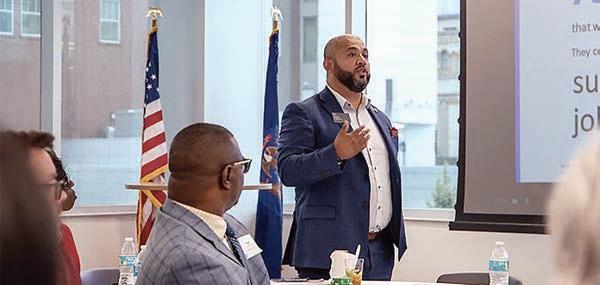
From Page 1
company’s net losses increased nearly 300%, while adjusted earnings before interest, taxation, depreciation and amortization (EBITDA) decreased by more than 230%.
Anaergia CFO Andrew Spence said during the earnings call that “substantial doubt exists about (the company’s) ability to continue,” despite efforts from management — including an executive restructuring — to improve profitability.
Hodson pointed to the Chapter 11 bankruptcy filing in May from the company’s Rialto Bioenergy Facility near Los Angeles as having a significant effect on the company’s financial results.
As well, Hodson highlighted the
From Page 1
have a transformational, generational impact on not only Muskegon, but the entire West Michigan region.”
Parkland Properties has been working since July with officials from the city, Muskegon County and Michigan Department of Environment, Great Lakes and Energy to plan the best path forward to clean up the site to carry out development plans.
The Muskegon-based developer plans to begin the first phase of construction in spring 2024. A complicated environmental cleanup process is expected to exceed $15 million. Rooks declined to disclose the price of the property sale, which is expected to close this year, and said the total project cost is unknown at this point.

The Sappi Paper Mill, previously called S.D. Warren, began operation in 1899 on the lakefront and closed down in 2009. At its peak the paper mill employed more than
The report is part of an initiative to quantify the economic contributions of the immigrant community, and also serves as an update to the New American Economic Impact Report for West Michigan that was published in 2018.
Meanwhile, as the U.S. population is getting older, immigrants make up a bigger percentage of the county’s working age than their U.S.-born counterparts. Immigrants were 27.3% more likely to be of working age in 2019 compared to their U.S.-born counterparts, helping meet the rising labor force demands in the area, according to the report.
As well, immigrants strengthened the local job market by helping to preserve or create 2,600 local manufacturing jobs in 2019 that would have otherwise been eliminated or moved elsewhere.
However, the report also shows some key areas where Kent County’s immigrant population is lagging national trends in entrepreneurship and naturalization rates.
The naturalization rate for Kent County’s immigrant population in 2019 was 39.7%, or nearly 22,800
manifestation of some financial risks surrounding six in-process Anaergia facilities in Italy. Days after the earnings call, Anaergia announced the sale of those facilities to lender Arjun Infrastructure Part-
people, compared to the national naturalization rate for immigrants of 48.7%.
“When an immigrant is able to naturalize, it can increase their earning potential, feeding into economic stimulation in the economy,” Asma Easa, manager of state and local initiatives at the American Immigration Council, said during a presentation of the report last month.
Obstacles to naturalization include language access issues, barriers accessing capital and challenges of understanding naturalization rights, Easa said.
“Sometimes this information is not being pushed out by nonprofits, local chambers or local governments, and there is a lack of education work,” Easa said.
Nationally, immigrants are more likely to be entrepreneurs than in Kent County. One in five entrepreneurs are immigrants and employ more than 8 million Americans, while immigrants in Kent County are 27% less likely to be entrepreneurs than their U.S.-born counterparts, according to the report.
“Not only does this go against the
Anaergia already had begun a previously disclosed strategic review approved by its board of directors, a plan that involved an executive leadership change and the appointment of both Hodson and Spence in their respective executive roles this summer.
Here in Michigan, Anaergia secured a $5 million grant from the Michigan Public Service Commission to support the development of the Kent County Bioenergy Facility, which would convert organic waste into renewable natural gas and fertilizer.
national average, but it does run opposite of the trend we see where immigrants are more likely to be entrepreneurs,” Easa said in an interview. “It’s not a positive data point, but it’s good data to have because it gives the chamber an opportunity that this is a space that is important to invest in to be able to support our immigrant community. When there is a community that has a low number of business owners and entrepreneurship, it does negatively impact the economic stimulation for them.”
The data point shows that the lo-
with 20% being funded by the county and 80% being funded from the partnership with Anaergia, per earlier reporting. DPW has said it would retain ownership of the facility with Anaergia building and operating the plant.
While executives in Anaergia’s earnings call did not specifically address the Kent County project, Hodson commented on a new shift for the company when it comes to financing any future Build-Own-Operate projects.
cal entrepreneurial ecosystem needs to be working more closely with immigrant communities, said Omar Cuevas, vice president of investor and corporate relations for the Grand Rapids Chamber. That could include working to build better relationships with the right community groups, increasing language access, or bolstering resources, Cuevas said.
“We can’t sit on our hands and wait for immigrants to come to us,” Cuevas said. “We need to be intentional and make sure that resources are getting to people.”
phase of the Kent County Sustainable Business Park requires $23 million in infrastructure improvements to be funded through grants and other sources.
Baas told Crain’s Grand Rapids in July that the county was working on bids for some of the infrastructure components in the hopes of having the bioenergy facility fully operational by early 2027, three years later than the department’s hopes for operations beginning in 2024 as reported in 2021.
ners based on the failure to secure financing to complete the projects. Before the results were reported,
1,000 people. The property was then decommissioned and many of the buildings on the property were demolished with the help of some state funding.
Parkland Properties is set to purchase the site from a group of local philanthropists called Pure Muskegon, which acquired the site in 2016 with the goal of remediating the legacy industrial property and converting it to a mixed-use project with residential units.
“These projects require a purchaser with the ‘know how’ and experience performing similar types of projects, and we felt an obligation to the community to pursue this acquisition and continue what Pure Muskegon started,” Rooks said.
Parkland Properties and city officials hosted a public engagement session on Sept. 28 at the Delta Hotel by Marriott Muskegon to discuss the redevelopment proposal and answer questions from the public.
The project will offer a “wide spectrum of housing options across all price points,” Rooks said, including primary and secondary homes as well as rentals, ranging
As well, state lawmakers allocated $5 million for the overall business park in the state budget around the same time. The total cost of the business park is estimated at $380 million,
“For all new Build-Own-Operate opportunities in the development pipeline, we plan to develop future projects with a financial partner who will fund all or the majority of the capital in these projects,” Hodson said during the August earnings call.
According to DPW, the initial
“We’re at nearly 100% design … we’re making great progress. We’re all but ready — we just need to have that anchor tenant,” Baas said in July, referring to the bioenergy facility.
It is now unclear when county commissioners will vote on the project.
clude public sidewalks, bike trails, waterfront public access to parks, a large public beach, kayak launch and fishing areas.
Meanwhile, Parkland Properties is also in the early stages of redeveloping the former Shaw Walker Furniture Co. property in Muskegon.
The 730,000-square-foot former industrial site will be transformed into a mixed-use development with 552 condominium and apartment units, a parking ramp and 17,000 square feet of commercial space.
from studio apartments under $1,000 a month to three-bedroom apartments. Condos may range from $200,000 to $400,000, while waterfront sites for homes ranging from 2,000 to 5,000 square feet could run from $150,000 to $250,000, he said.
“There are also large executive waterfront homesites between that we expect to be between $600,000 to $800,000 that will be able to accommodate homes as large as 10,000 square feet with views of the Muskegon channel, and preserved parkland with forest, large sand dunes
and the sunset above,” Rooks said.
The proposal would further activate the Lakeshore Drive retail corridor, which borders the south end of the paper mill property. Parkland Properties and the city are researching the best retail uses to support the surrounding neighborhood, which could include restaurants, breweries, distilleries, bars, a fitness center, hair salon, massage therapy, day care, pet care or coffee shops.
As well, the developer plans to expand the amount of public spaces along Muskegon Lake with the project. Public amenities could in-
Remediation and construction work on the Shaw Walker site is slated for 2024 for the first phase of 378 residential units and retail space.
The $220 million project recently received a $1 million redevelopment loan from EGLE. The project was also awarded an $18 million allocation in the state’s fiscal year 2023-24 budget.
“We believe there is a lot of synergy between these two legacy projects whether it be construction, marketing, sales, etc., and it makes sense for us to perform them together,” Rooks said.
“We’re at nearly 100% design … we’re making great progress. We’re all but ready — we just need to have that anchor tenant.”
Dar Baas, director at Kent County DPWOmar Cuevas of the Grand Rapids Chamber speaks at an event on Monday, Sept. 11, upon the release of a new economic impact report. | COURtESY The former Sappi Paper Mill on Muskegon Lake closed in 2009 and has since been demolished. COURtESY according to CEO Tyler Adams.
Cronkright and Lawrence Duthler, who are partners at Grand Rapids-based Sun Title Co., formed CertifID with Adams after they experienced a $180,000 wire fraud loss in 2015.
Through mid-2024, CertifID plans to retain a focus on the real estate sector where “we’re just so embedded and intently focused to solve this issue,” Cronkright said.
“There’s still a lot of market share either we haven’t been exposed to or haven’t been able to influence … from a service and offering perspective,” he said. “There’s still a lot of work to do in real state. Wire fraud in real estate is hands down the No. 1 risk factor that we face on a transaction-by-transaction basis.”
In plotting the future for CertifID, executives will consider new products and services “that further the validation of identity” in business transactions involving
From Page 3
do events and also begin to activate the river in other ways we haven’t been doing in a while.”
The city commission approved a contract with Rockford Construction for the project on Sept. 19, and is set to consider authorizing the bonds on Oct. 10. Miller said the bonds likely will be lower than the $12 million that the DDA approved last month.
The design process for Lyon Square ramped up in October 2020, led by Downtown Grand Rapids Inc., in collaboration with Progressive AE and Rockford Construction. Site plans call for removing existing road, sidewalk, curb and amphitheater areas to create a more modern and pedestrian-focused public plaza. Vehicle access would be maintained in Lyon Square for the convention center parking ramp and loading docks at
wire transfers, Cronkright said. New markets the company could enter include M&A transactions where buyers pay sellers, wealth management and brokerage firms, insurance payouts, law firms processing litigation settlements, and other professional service sectors where “you’re dealing with large sums of other people’s money,” he said.
Sectors beyond real estate could use a better ability to verify the identification of parties involved in electronic funds transfers that are susceptible to cybercriminals intercepting payments, he said.
“The root cause is a lack of identity verification at some inflection point in a communication or a transaction,” Cronkright said.
The FBI’s Internet Crime Complaint Center took more than 800,000 complaints in 2022 that held the potential for $10.2 billion in losses across all types of fraud.
Complaints about business email compromises that often target the transfer of funds by businesses and individuals reached nearly 22,000 last year, generating $2.74
the convention center and hotel.
The design team started working on the project in 2020, but various consultants have worked on the concept for the past 10 years, Miller said.
Plans for Lyon Square also include significant landscaping and adding more tree canopy, lighting
billion in losses, according to the Internet Crime Complaint Center’s 2023 annual report the FBI issued in May.
Real estate wire fraud is a subcategory among business email compromise scams that are “one of the fastest growing, most financially damaging internet-enabled crimes,” according to a November 2022 FBI report to Congress.
As CertifID prepares for the future, executives are “going to be very strategic in how we evaluate those markets and what our entry point would be,” Cronkright said.
“It would be a lot of intention before we truly run after a new vertical because there’s so much to be solved in real estate, but I think real estate provides enough texture between business to business and business to consumer (transactions) that the personas — just swap out the industry verticals — are representative in other industries,” he said. “It’s the same threat, it’s the same playbook. It’s just a different industry and a different transaction type that they’re trying to divert funds from.”
project is consistent with objectives laid out in the city’s GR Forward investment plan and strategy, which aims to anchor downtown to the Grand River.
“This is the first domino for a series of things where we can show progress and create some really good public spaces and opportunities for events and a whole series of river opportunities,” Miller said. “We want to get something built and constructed and use this as an impetus and springboard for other projects around the river.”
Plans for a restaurant and bar at a vacant downtown Grand Rapids building recently moved forward with approval by the city’s planning commission.
Kitchen hours would be 11 a.m. to 11 p.m. every day, with a closing time of 2 a.m. Any exterior changes to the building are subject to city Historic Preservation Commission review.
“I think this is a super exciting project, and a good reactivation of the building,” Planning Commissioner Laurel Joseph said during the Sept. 14 meeting.
From Page 3
to show itself in those numbers.”
The report also shows that tech job postings increased 82% between 2020 and 2022. The median advertised salary for those postings is $90,000.
Key skills as advertised in the job postings include structured query language (SQL) for programming, JavaScript programming language and Microsoft Azure, among other applications.
The progress report also highlights insights from commercial real estate and investment firm CBRE, which indicate that Grand Rapids ranks seventh among emerging tech markets in North America and ranks third as an emerging market for high-tech job growth.
“We’re off to a fast start in terms of growing tech, and the vast ma-
features, brick paver surfaces, a covered river overlook, outdoor fireplace, public seating, and a sidewalk snowmelt system. The
jority of those tech jobs are created by our existing company base. That’s a strong signal that there’s a high degree of tech adoption across the region,” Thelen said. “You see that reflected in the job growth, you see that reflected in the job posting growth, and you also see it reflected in the CBRE study that recognized Grand Rapids as an emerging tech hub.”
Looking ahead, Thelen said continuing to grow the tech talent pipeline in the region remains a critical component and potential challenge with executing the strategy.
“The talent pipeline is something that is critical. We’ve got to find a way to increase the volume of people that are taking courses, that are pursuing degrees at our universities or that are taking courses or certifications toward tech employment,” Thelen said. “The demand is definitely higher … so getting labor supply to match up with that tech
Rockford Construction plans to start construction on Oct. 6 along the riverfront portion of the project while the Grand River is in a “low water period,” Miller said. The riverfront component would be built from October through about January 2024. The bulk of the rest of the project would likely start in April, with a targeted completion in November 2024, Miller said.
labor demand is a big deal.”
Thelen also noted the need to grow the availability of capital in the region. The report shows a higher volume of deals and higher amounts of capital raised in the years since 2019 compared to the 2014-2018 timeframe, but Thelen said he hopes that keeps growing.
“We’ve made good headway over the last five to 10 years, but we’ve got to get to another level and continue to look for ways to grow our seed, angel and venture capital availability,” he said.
Meanwhile, the second annual Tech Week in September was a testament to collaboration within the local technology sector, Thelen said.
“This isn’t just The Right Place’s strategy — it’s a regional strategy, and everybody is finding their place within the plan and executing that,” Thelen said. “I think it’s a pretty powerful testament to the collaborative spirit of West Michigan.”
The commission on Sept. 14 approved a restaurateur’s special land use request to repurpose the vacant building at 59 Commerce Ave. SW. The approval was needed to operate the establishment past midnight.

The owners of the Win Tavern 33 in Jenison have set their sights on downtown Grand Rapids with the new concept, known as Tavern 59.
The goal is to be “a restaurant first, and a bar second,” an approach that differs from other nearby establishments, said Mike Hanrahan, partner at CBH Attorneys and Counselors, on behalf of Tavern 59 owners.
The vacant, 4,445-square-foot building is located next to Stella’s Lounge and previously housed Matrix Wine Cellars and Matrix Construction. Win Tavern 33 co-owner Robert Wahl purchased the property on July 31 for $775,000 from Mark Sellers.
The Tavern 59 dining room is set to be 2,300 square feet with the space to seat 118 people and employ about 60 staff, according to city planning documents.
As of Sept. 20, Wahl’s request to transfer a Class C liquor license to the location, as well as a specially designated merchant license, which would allow a restaurant or bar to sell to-go drinks, was still under review by the Michigan Liquor Control Commission.
The menu would be similar to The Win Tavern 33 in Jenison, focusing on “traditional American table-fare,” such as burgers and sandwiches, according to a planning memo.
Sellers, the owner of nearby Max’s South Seas Hideaway who formerly launched the HopCat chain of beer bars, initially acquired the property for $875,000 in 2014. At the time, Sellers planned to open a barbeque and tiki restaurant called The Shrunken Head.
Those plans eventually fell through, and Sellers’ BarFly Ventures LLC filed for Chapter 11 bankruptcy in mid-2020. In early 2021, 59 Commerce Ave. went into foreclosure and was acquired by another buyer in a sheriff’s sale. Sellers then repurchased the commercial real estate later in 2021 for nearly $600,000.
Solutions Engineer (Compac Sorting Equipment, Inc.) (Grand Rapids, MI): Produce layouts & designs for fruit handling & packing solutions that are fit-for-purpose, market relevant, profitable & meet customer needs. Reqs. Bachelor’s in Mechanical Engineering, Electronics Engineering, Mechatronics Engineering, or related plus min 2 yrs of engineering exp. in agriculture automation industry. Exp. must include analyzing & designing engineering solutions to address customer requirements; & managing food production & packing process for various fresh produce commodities, including compliance with handling requirements. Exp. must also include working with following tools & technologies: customer relationship management (CRM), 2D layout design software, including AutoCAD; 3D product design software, including SolidWorks; integration of electrical & control systems for packhouse management; packaging machinery & material handling systems; flow diagram tools for system definition, interaction points & data management; data modeling tools to analyze customer information & requirements; production line optimization methodologies; advanced excel skills; & Microsoft Office Suite. Exp. must include min. 2 yrs participating in sales or service organization with focus on enhancing customer experience. 30% of domestic & international travel typically required. Destination & frequency impossible to predict. Telecommuting is permitted w/ in commuting distance of worksite 3 days/week. Send resumes by mail to Compac Sorting Equipment, Inc., Attn: Alexander Paradiang, Director of Global Solutions, at 728 N. American St., Visalia, CA 93291 or by email to alex.paradiang@tomra.com”
“We want to get something built and constructed and use this as an impetus and springboard for other projects around the river.”
Mark Miller, director of planning and design for Downtown Grand Rapids Inc.
Mark Secchia moved back to his hometown of Grand Rapids about two years ago after being away for decades. The son of the late businessman, philanthropist and political activist, Peter Secchia, scrapped his plans to develop a bocce entertainment center in Silicon Valley during the COVID-19 pandemic, pivoting instead to bring the project to his hometown. The entrepreneur says he is now focusing all of his energy on fully renovating a 50,000-square-foot building at 975 Ottawa Ave. NW in the city’s Monroe North neighborhood. The structure has housed several uses over the past 102 years after it was built in 1921 as an extension of the Berkey & Gay Furniture Co. The building housed manufacturing uses for the furniture company, as well as a gymnasium and entertainment center for the company’s employees. Most recently, the structure housed the Riverfront Fitness Center. Secchia plans to convert the building into an entertainment venue called Silva, which will include a restaurant, bar, private event space and state-of-the-art bocce courts. Secchia designed Silva with the same spirit as many of his father’s retail and restaurant ventures, particularly Tootsie Van Kelly’s, which operated until the mid-1990s in the Amway Grand Plaza Hotel. Secchia plans to open the Silva in phases, starting with the restaurant by July or August of 2024. Secchia founded several companies in the 21 years that he lived in China, including Sherpa’s, a food delivery platform similar to DoorDash. Secchia grew the company to a team of about 500 employees and sold it to a group of venture capitalists. Secchia recently discussed his long-held plans and bigger meaning behind Silva, as well as the role of younger generations of Grand Rapids’ powerbroker families in charting the city’s future. |
By Kate CarlsonThe Silva building is an ArtPrize venue this year, and you recently hosted an open house in the space. How has it been to see the vacant space activated with people and art?
The first feeling of having somebody walk in for ArtPrize was something I’ve never experienced before. We’ve been here for five months in an active construction zone, just kind of building toward this future we want to have open somewhere toward the middle or end of next year. And then to just have people walk in the front door and greet them and just say the name, ‘Silva,’ felt super cool but also super real. Until now it was just this construction thing that at any point we could walk away and sell if we needed to. We didn’t feel like we were building name brand equity before.
How did you pick the name Silva for the project?
Silva means tree, or lumber, in Latin. About half of this building was lumber drying kilns and cutting rooms used to send lumber over to Berkey & Gay Furniture Co. next door, which is now the Boardwalk Condos. The other half of choosing the name was my father’s company, Universal Forest Products (now UFP Industries). A little bit of the money for this project came from his estate, so it’s a little bit of an homage to him.
You’ve lived and worked outside of West Michigan for a while. Did you ever see yourself coming back? No, but it just has this pulling power. I left in 1988 and didn’t move back until about two years ago. One of the reasons we moved back is every time we came (to visit) we just enjoyed it so much. Living in California during COVID, there really isn’t that much to do. There are only so many hikes you can go on until it gets kind of boring, then we would come back
here, go camping and go swimming in the lakes and the rivers and it’s so green.
Similarly, how has your relationship to West Michigan changed since you’ve lived elsewhere for so long?
This is certainly our forever home. We’ve lived in other houses in California and in Shanghai and we never really thought those were going to be our forever homes, it just kind of felt transient like we were going to be there for five or 10 years until the next thing. But not anymore — this is it for us. I sound like I’m a walking billboard for Grand Rapids, but now I understand why my dad used to always call it the center of the universe.
Your parents are well known in Grand Rapids, in part for their donations to many different projects and causes. What is your philosophy on philanthropy?
I’m a tiny fish in that pond. You
have to kind of get your roots down and find the things you want to support and do. My dad had a lot more funds than I do and spread it a lot wider than we will, but right now we’re so focused on the restaurant (in Silva) that I haven’t really gone down the philanthropic path yet.
Grand Rapids had a generation of power brokers, but some people from the newer generations are moving away or aren’t around anymore.
What’s your view on the role of younger generations in charting the city’s future?
Grand Rapids has been set on such an amazing path when you compare it to Kalamazoo, Lansing and Detroit on what we’ve been able to do and the success we’ve had, and so much of it was due to that power broker group. I don’t know if there is a void because that would be offensive to people who are maybe stepping in and filling that role, or maybe they’re just being less
public. But you don’t see a name going up on a building right now that you didn’t recognize from the past. Some people have said ‘That’s a void you can step in and fill,’ and that’s not my game. I’m not a salesman and don’t have the experience. Maybe 10, 20 years down the road.
Grand Rapids is in a period of growth right now with several transformational projects in the works. What do you think needs to be part of that vision of development downtown and around the city?
It’s that group of power brokers behind the curtain, that’s really what it comes down to. As great as the local government is, the way our governments are built in America is transient. Then there are these power brokers that will see 20 mayors come and go over the years, but those folks are always there, and that’s what I think needs to happen to the city.
Can you talk a little more about Silva and why you’re developing this project in Grand Rapids?
I’ve always been an entrepreneur in the retail world, and it’s just an itch getting scratched to be able to entertain and delight people. During ArtPrize people were telling us they are so happy to see the space being renovated again and the city is telling us they are happy that someone is breathing life into this part of town.
That is exactly the adrenaline rush I love, and carrying that all with you to opening, whether it’s providing someone with a good meal, server experience or good event, that’s such a great feeling when you’re in this sort of retail business.
Then the other half of it is certainly because this goes along a lot with my father’s wishes. He always wanted Grand Rapids to be better and better and improve the city, and I certainly think this is something that falls under what he would have wished for.
CrainsGrandRapids.com
President and CEO KC Crain
Group publisher Jim Kirk, (312) 397-5503 or jkirk@crain.com
Executive editor Mickey Ciokajlo, mickey.ciokajlo@crain.com
Editor Joe Boomgaard, joe.boomgaard@crain.com
Managing editor Andy Balaskovitz, andy.balaskovitz@crain.com
Special projects editor tim Gortsema, tim.gortsema@crain.com
Director of audience and engagement Elizabeth Couch, elizabeth.couch@crain.com
Audience engagement editor Matthew Pollock, matthew.pollock@crain.com
Creative director thomas J. Linden, tlinden@crain.com
Associate crative director Karen Freese Zane
Digital design editor Jason McGregor
Art directors
Kayla Byler, Carolyn McClain, Joanna Metzger
Senior digital news designer Stephanie Swearngin
Notables coordinator Ashley Maahs
REPORTERS
Kate Carlson, real estate, kate.carlson@crain.com
Jack Grieve, audience engagement, jack.grieve@crain.com
Abby Poirier, restaurants, retail and agribusiness, abigail.poirier@crain.com
Mark Sanchez, health care and finance, mark.sanchez@crain.com
Kayleigh Van Wyk, manufacturing, technology and law, kayleigh.vanwyk@crain.com
Rachel Watson, residential real estate, insurance and tourism, rachel.watson@crain.com
Danielle Nelson, research and data, danielle.nelson@crain.com
ADVERTISING
Senior vice president of sales
Susan Jacobs, susan.jacobs@crain.com
Advertising & event sales director
Jill May, jill.may@crain.com
Account executive
Shelly Keel, shelly.keel@crain.com
Michigan events director
Samantha Flowers, samantha.flowers@crain.com
Marketing and events coordinator
Matthew Chaffee, matthew.chaffee@crain.com
People on the Move manager
Debora Stein, dstein@crain.com
Classified sales
Suzanne Janik, sjanik@crain.com
Sales assistant Rachel Smith
Inside sales tawni Sharp
CRAIN’S CONTENT STUDIO
Senior director of Crain’s Content Studio Kristin Bull, kbull@crain.com
Crain’s Content Studio manager Clare Pfeiffer
Content marketing specialist Allie Jacobs
PRODUCTION
Vice president, product Kevin Skaggs
Product manager tim Simpson
Prepress/production director Simone Pryce
CUSTOMER SERVICE
(833) 830-7446 toll free (845) 267-3031 local line (for any foreign calls) customerservice@crainsgrandrapids.com
Crain’s Grand Rapids Business is published by Crain Communications Inc.
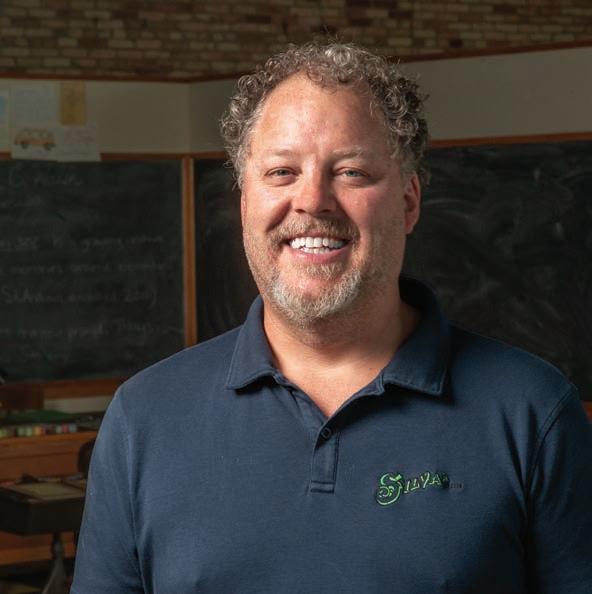
Chairman Keith E. Crain
Vice chairman Mary Kay Crain
President and CEO KC Crain
Senior executive VP Chris Crain
Chief Financial Officer Robert Recchia
G.D. Crain Jr. Founder (1885-1973)
Mrs. G.D. Crain Jr. Chairman (1911-1996)
Editorial & Business Offices
1155 Gratiot Ave., Detroit MI 48207-2732; (313) 446-6000
Volume 40, Number 20
Crain’s Grand Rapids Business (ISSN 2836-7723) is published biweekly, with an extra issue in May, October and December, by Crain Communications Inc. at 1155 Gratiot Ave., Detroit, MI 48207-2732. Periodical postage paid at Grand Rapids, Michigan.
© Entire contents copyright 2023 by Crain Communications Inc. All rights reserved. Reproduction or use of editorial content in any manner without permission is prohibited.
Subscriptions: $59 per year. Advertising rates and specifications at www.crainsgrandrapids.com or by request. Crain’s Grand Rapids Business does not accept unsolicited contributions.
Postmaster: Send address changes to Crain’s Grand Rapids Business, 1155 Gratiot Ave., Detroit, MI 48207-2732.






When we say you belong here, we don’t just mean on the grounds of Beacon Hill. We also mean in the greater Eastgate neighborhood, and in all of Grand Rapids. You can still attend cultural and charity events, museums, festivals, and all the other activities you’ve always loved. Our drivers will even take you there.




Life Plan Communities provide the answer for the growing number of adults who are looking for the opportunity to enjoy an active, independent retirement while still planning for the future.


INDEPENDENT LIVING ASSISTED LIVING
MEMORY CARE
SKILLED NURSING & REHABILITATION (both short- and long-term)


Beacon Hill’s care team is committed to keeping couples together. If you or your spouse ever need a different level of care, your options are all right here. Featuring beautifully-designed apartment homes for independent living and also on-campus assisted living, skilled nursing, rehabilitation, and memory care.
Beacon Hill has a rich tradition of providing topnotch skilled nursing services in a comfortable and welcoming setting for over 60 years. The skilled nursing portion of our Beacon Hill facilities are stateof-the-art and equipped to care for the needs of our growing community.



A Life Plan Community is a particular type of retirement community that offers several levels of care on one campus: 1 919 BOSTON STREET S E GRAND RAPIDS, MI 49506

No matter what life brings.